The Fujifilm X-T30 hit the magical sweet spot of offering the same sensor as the flagship camera in the X-series range (at the time), and for many people, who didn’t need the weather-sealing, this camera was considered, and still is considered the bargain of the century. Offering exceptional Fujifilm image quality at exceptionally low prices, especially on the second-hand market.
Fujifilm X-T30: at a glance
- 26.1-million-pixel APS-C X-Trans CMOS 4 sensor
- ISO 160-12,800 (80-51,200 extended)
- 425-point AF system with 2.16-million phase detection pixels
- Up to 30fps continuous shooting
- 4K/30p recording with 4:2:2 10bit HDMI output
- Single SD card slot
- £849 body only

Those working to a sub £1000 budget can purchase the X-T30 with the XC 15-45mm f/3.5-5.6 OIS PZ kit lens for £899. Photographers after the best kit option will want to choose it with the XF 18-55mm f/2.8-4 R LM OIS lens (£1,199), which is the combination pictured above
There have been a number of developments in Fujifilm’s X-series over the years. One example has been the expansion of the company’s X-T camera portfolio. At the beginning of 2014, there was only the X-T1 to choose from if you fancied a Fujifilm camera that bestowed the traditional shape of a DSLR, with attractive styling and a centrally positioned viewfinder. We had to wait until May 2015 to witness some of the X-T1’s features filter down to a more compact X-T10.
Since then we’ve seen the X-T series grow substantially. Double-digit X-T models such as the X-T20 continue to borrow a subset of the advanced features found in Fujifilm’s single-digit X-T models, and to ensure there’s a camera for all types of user, Fujifilm introduced the X-T100 as an entry point for novices and those working to a strict budget.
With Fujifilm’s so called ‘little giant’ we’re looking at a smaller, lighter and more affordable alternative to Fujifilm’s fabulous X-T3 that has been well received since its launch last year. The X-T30 has great promise, but still has a lot to do if it’s to follow in the X-T20’s footsteps and become Fujifilm’s next best selling mirrorless camera.
Fujifilm X-T30 Review: Features
The X-T30 benefits from Fujifilm’s 4th generation X-Trans CMOS 4 technology and is equipped with the same 26.1-million-pixel APS-C X-Trans CMOS 4 sensor you get in the X-T3. This chip has a back-illuminated structure, excludes a low-pass filter to maximise detail and partners up with Fujifilm’s X-Processor that’s 3x faster than the one used inside the X-T20. Whereas previously ISO 160 was only available as extended ISO, users will find it part of the native range, which spans from ISO 160-12,800 (expandable to ISO 80-51,200).
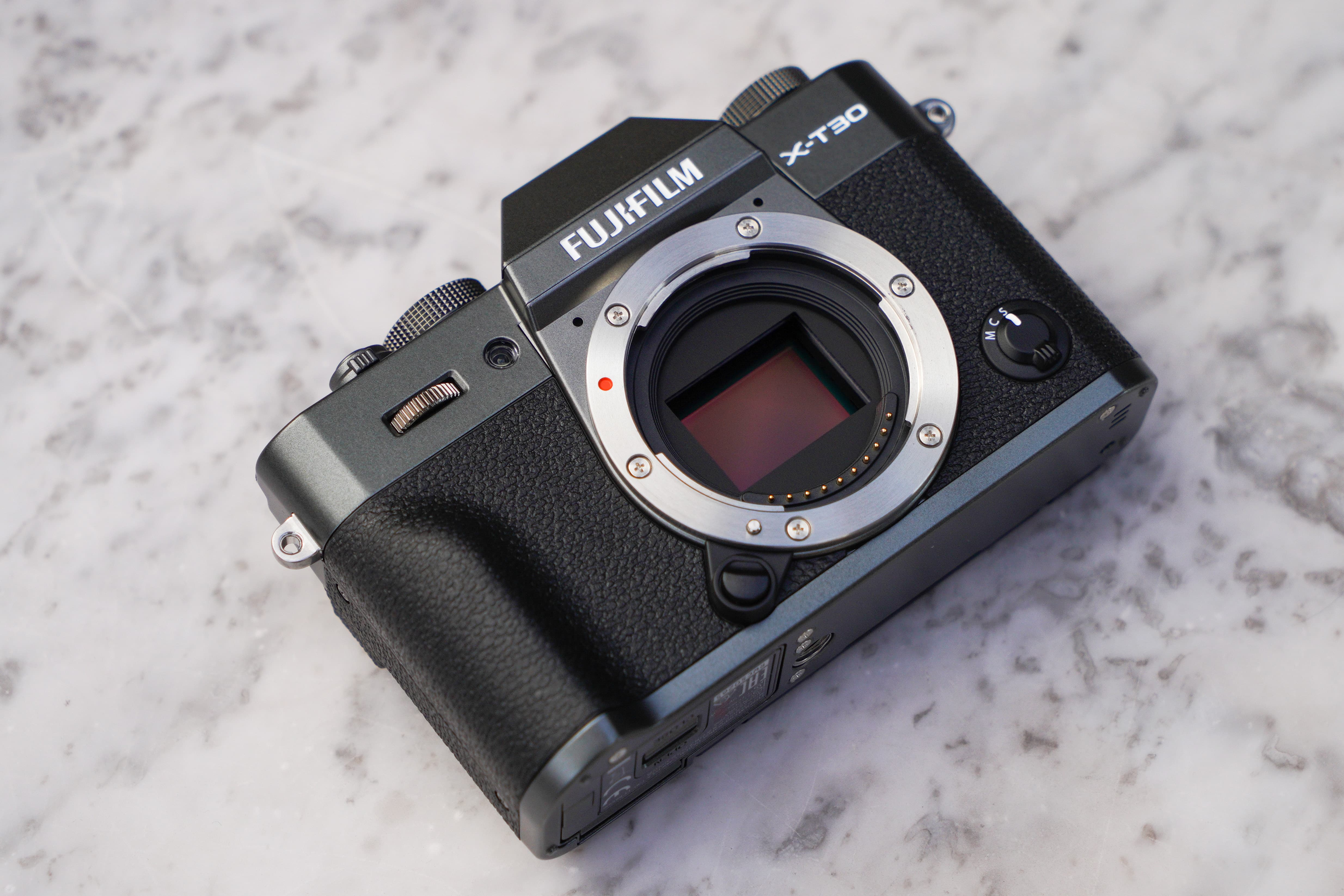
The X-T30 will be made available in this attractive charcoal grey finish as well as black and silver
The X-T30 shoots at 8fps using its mechanical shutter, which is 3fps slower than the X-T3. Unlike the X-T20 that maxed out at 14fps using its electronic shutter, faster continuous shooting speeds of up to 30fps are possible, but this does enforce a 1.25x crop of the sensor, resulting in 16-million-pixel images being captured. To help with composition, the Sports finder mode that clearly marks the 1.25x cropped area in the viewfinder has been carried across from the X-T3.
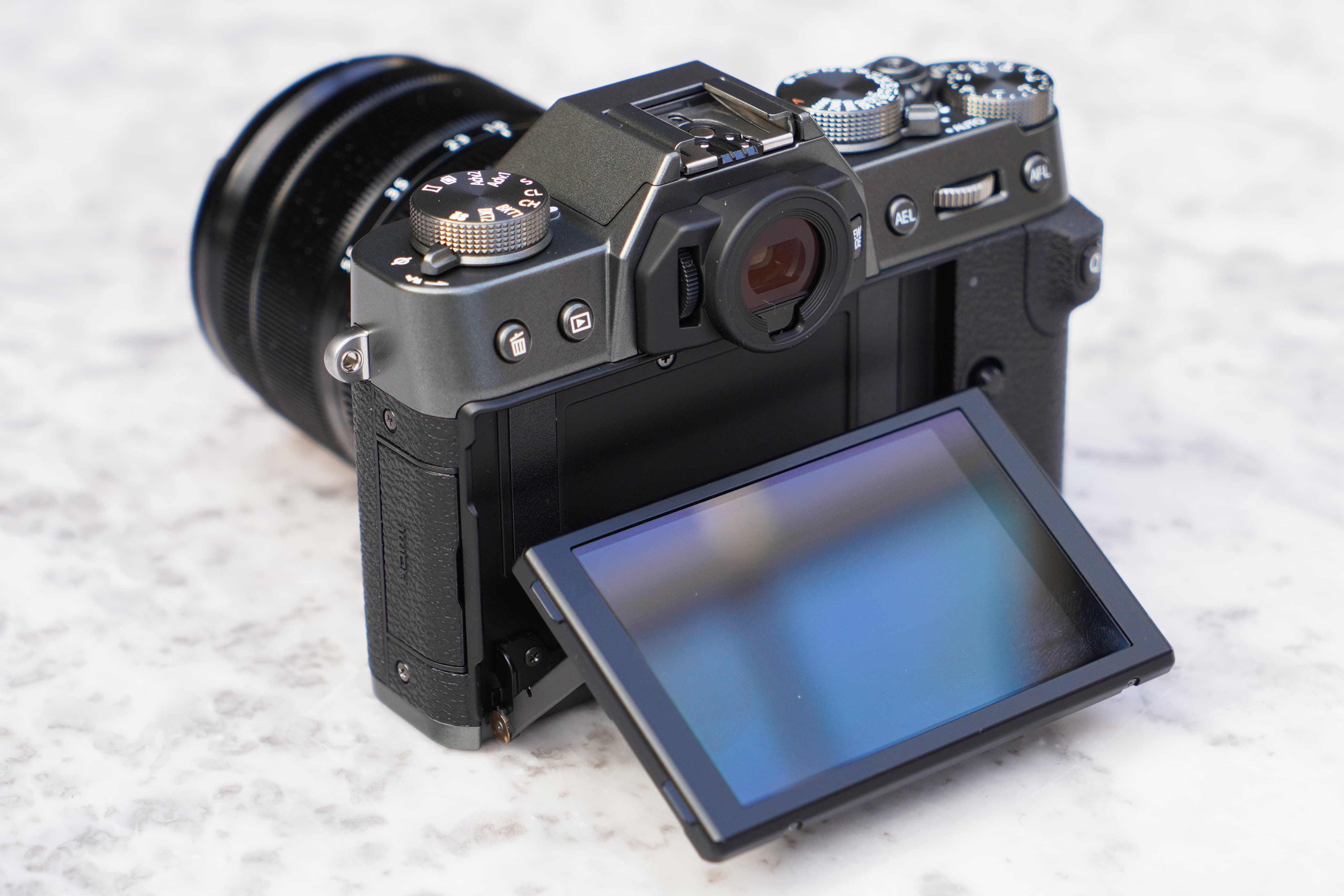
The X-T30’s screen is different to the X-T3’s and offers two-way tilt as opposed to three-way tilt
The fastest the X-T30 shoots at using its electronic shutter without the 1.25x crop is 20fps. Users can expect to record 32 JPEGs or 17 Raw files continuously at 20fps, or 90 JPEGs or 18 Raw files at 8fps, which doesn’t trump the X-T3’s buffer performance.
Another variation between the X-T30 and X-T3 is that the latter shoots up to 1/8000sec using its mechanical shutter, whereas the maximum shutter speed on the X-T30 is 1/4000sec. When a faster shutter speed is required or silent operation is needed for discreet shooting, the electronic shutter can be used to shoot at up to 1/32,000sec. At the opposite end of the scale, it’s possible to set the shutter speed to as slow as 60mins using bulb mode or 15mins in shutter priority or manual mode.
As has been the case on previous X-series cameras, users will find the extended ISO settings are only available when using the mechanical shutter. Select the electronic shutter and the ISO range is limited to ISO 160-12,800.
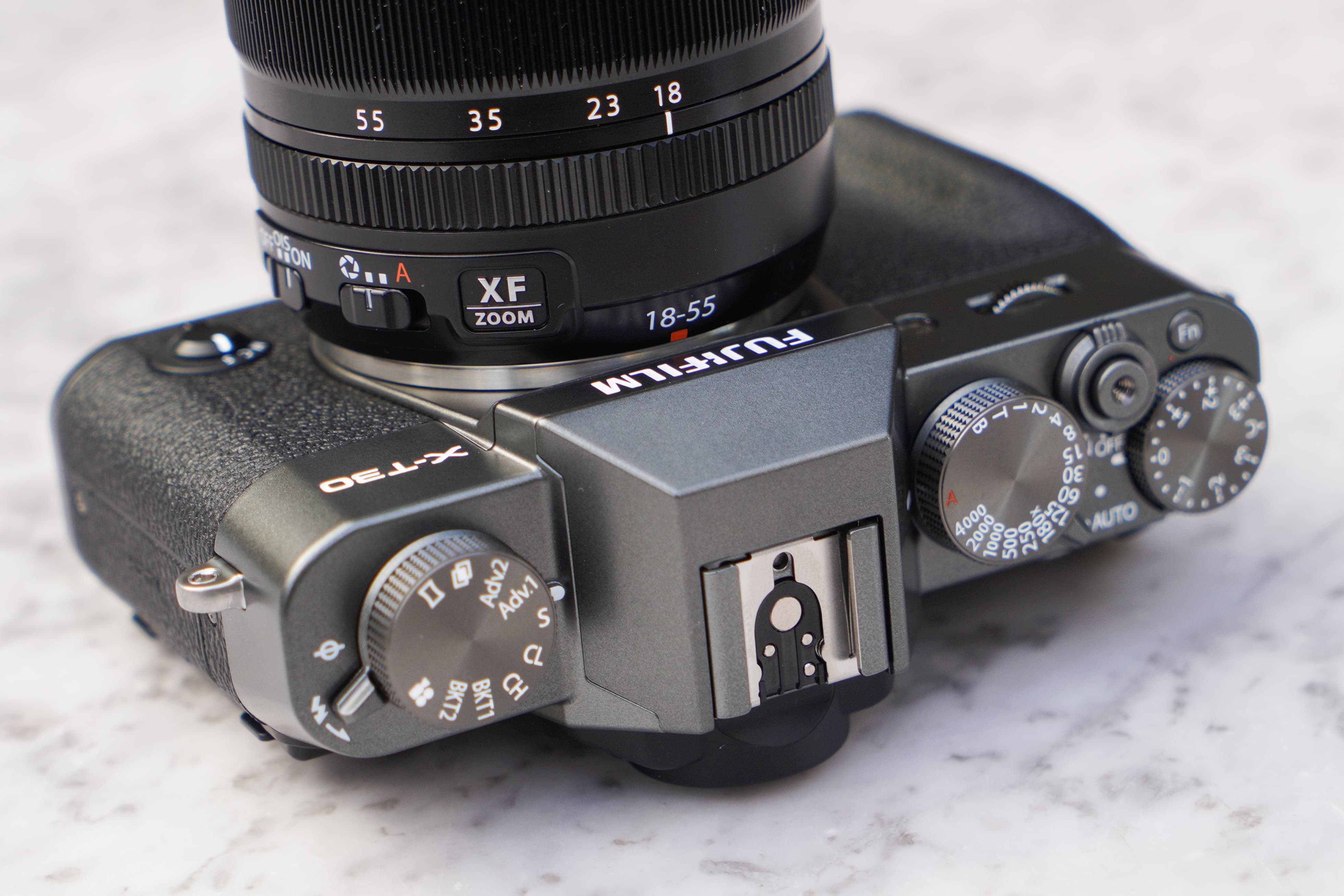
Metal dials on the top plate provide direct access to shutter speed, exposure compensation and drive settings
One of the key talking points on the X-T30 are the improvements to its autofocus system. It inherits the same sophisticated AF system from the X-T3 with four times as many phase detection pixels on the sensor than you get on the X-T20. The 2.16-million phase detection pixels cover 100% of the frame and the low-light autofocus sensitivity has improved from -1EV to -3EV. Users get a choice of either 117 selectable AF points laid out into a 9×13 grid, or there’s a 425-point layout consisting of a 17×25 grid, plus there are custom AF-C modes to enhance focus tracking when shooting moving subjects.
Much like the X-T3, single and continuous AF modes are selected via a switch at the front of the body and you get five custom AF-C modes to refine focus tracking when shooting moving subjects. The difference between the X-T30 and X-T20 is that you can manually adjust the tracking sensitivity, speed tracking sensitivity or zone area switching to create your own custom AF-C preset.
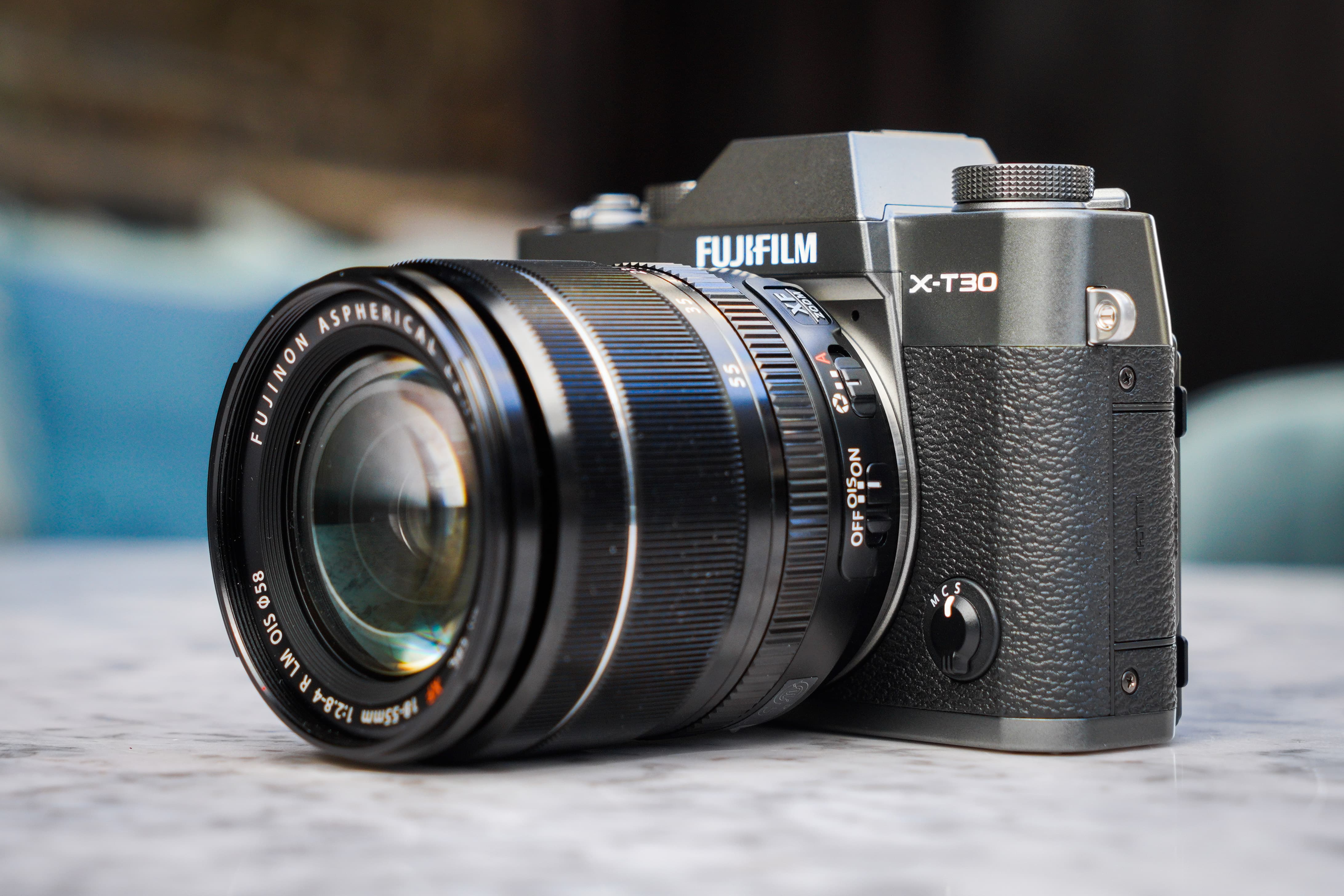
Focus mode is selected from the front corner of the body via a AF-S/AF-C/manual switch
Following feedback from X-T3 users, the updated autofocus algorithm is intended to rule out the jittery performance that’s associated with Face and Eye tracking, Face Selection and Non-stop Phase Detection AF when focusing from distance. The algorithm has been amended so it can identify smaller faces in the frame as well as provide faster focusing from far to near or near to far when using phase-detection AF in combination with long telephoto lenses. Fujifilm X-T3 users can benefit from these improvements too via version 3.00 firmware.
The X-T30’s centrally positioned EVF is a similar 2.36-million-dot OLED unit as you get on the X-T20. It features a 0.62x magnification, dioptre adjustment, and an eye sensor that permits automatic switching with the rear screen. Up to the eye, it displays extensive exposure information, plus it automatically rotates when you switch from landscape to portrait orientation and vice versa. The display time lag of the EVF is just 0.005sec and it has a refresh rate of 100fps when the camera is set to its high performance boost mode. In normal mode the EVF’s refresh rate is 60fps.
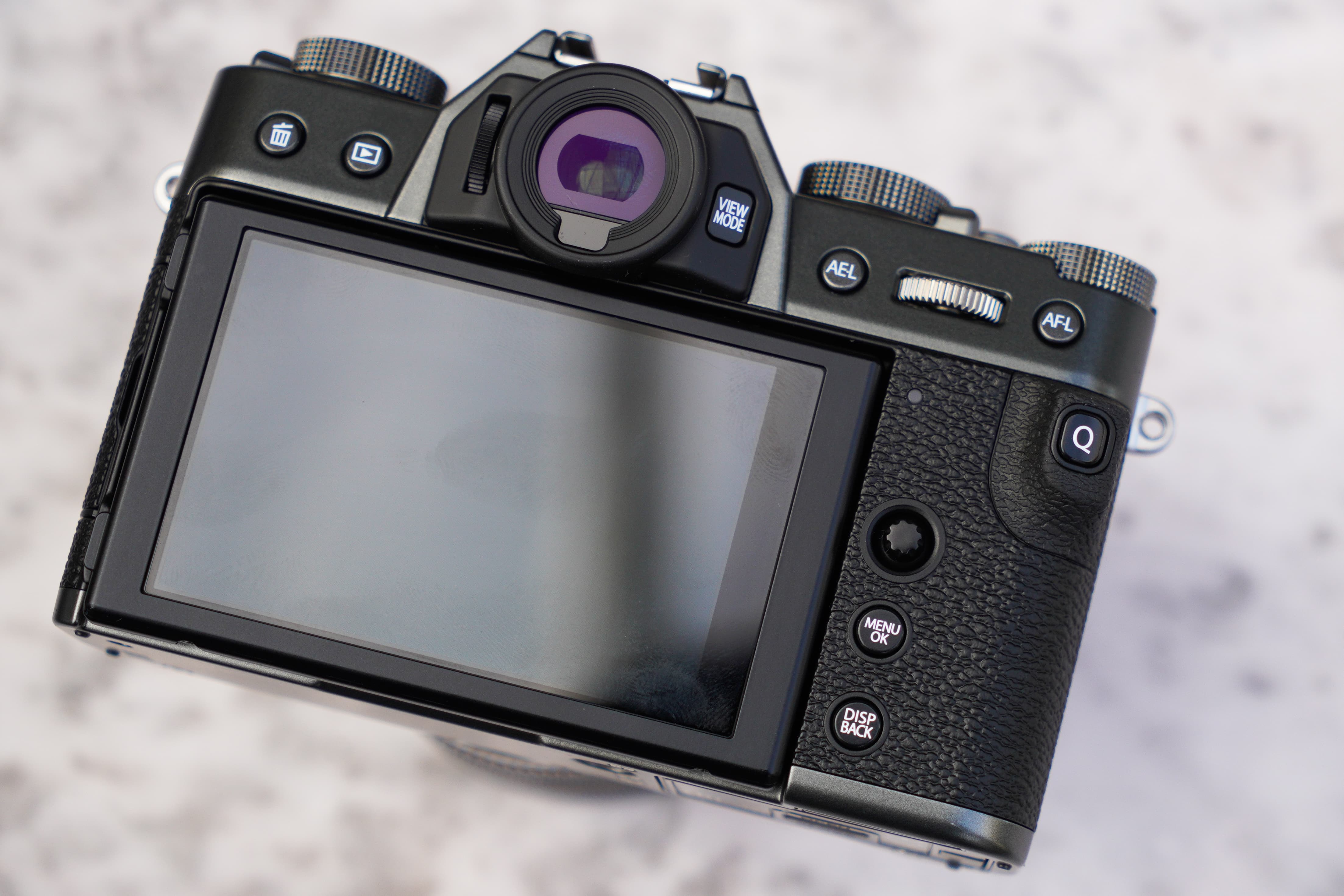
The introduction of a joystick and repositioning of the quick menu button are the big control changes at the rear of the X-T30
Below the EVF, the X-T30’s 3in, 1.04-million-dot touchscreen is similar to the X-T3’s screen in terms of size and resolution, but offers two-way tilt manoeuvrability as opposed to three-way tilt. The screen is 1.3mm thinner than the X-T20’s and with touch-based control it’s possible to adjust the AF area while looking through the viewfinder, change settings from the quick menu and swipe through or magnify images from a touch of your finger.
Other features that see the X-T30 advance on the X-T20 include its ability to shoot ultra high definition (UHD) 4K/30p video with support for F-Log recording, 4:2:2 10bit output via HDMI and 4:2:0 8bit output in-camera. It also offers 48KHz 24bit stereo sound recording in body and the USB-C interface that’s found at the side for charging the battery on the go doubles up as the X-T30’s headphone plug. Directly above this is a 2.5mm mic/remote input, with a single SD card slot found adjacent to the battery.
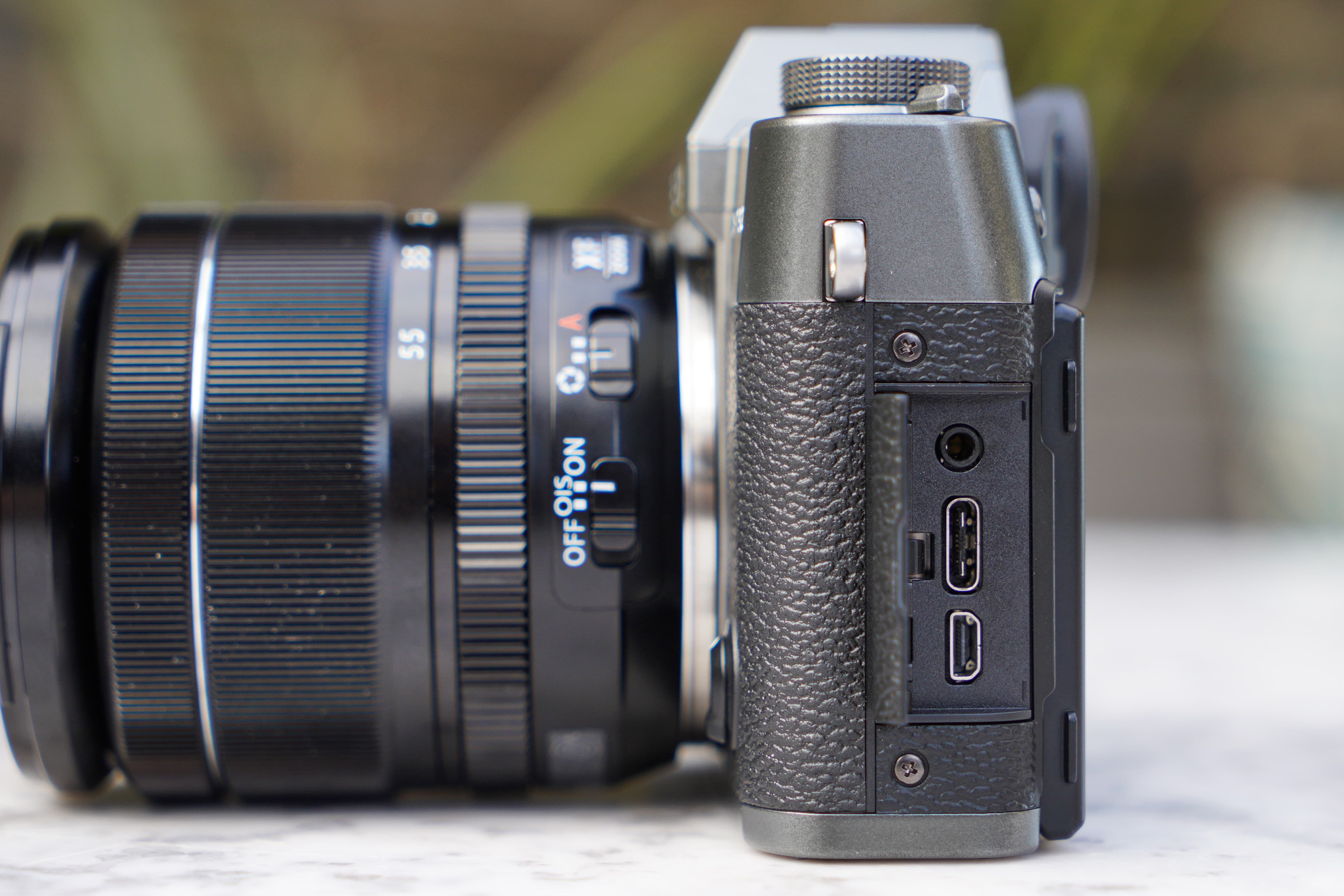
From top to bottom; the 2.5mm mic port, USB Type-C terminal and HDMI micro connector (Type D)
All of the above is backed by Fujiflm’s suite of film simulation modes, which includes Eterna that creates subdued colours, smooth halftones and soft shadows. Connectivity wise, the X-T30 can be paired with a smart device via Bluetooth for an always on connection, enabling a fast and automatic transfer of images ready to share. Wi-fi and Bluetooth also permits remote shooting from a smartphone, viewing of pictures taken on your device, and direct printing to an Instax printer.
Fujifilm X-T30 Review: Bluetooth connectivity
To activate the X-T30’s Bluetooth connectivity you first need to enter the connection settings via the main menu, select ‘Bluetooth settings’ and then click on ‘pairing registration’. From here you’ll be promoted to load Fujifilm’s camera remote app on your mobile device and select the pairing registration option.

Wireless communication can be activated quickly by setting it to one of the X-T30’s custom function buttons
After selecting the X-T30 on your mobile device the camera will ask if you’d like to set the date/time from the smartphone. Confirm this and the Bluetooth set-up process is complete. Each time the Camera Remote app is loaded from this point on, the camera and mobile device automatically connect (provided that Bluetooth on both devices is turned on) – a process that takes only a few seconds after which the remote control, receive, browse camera and geotagging options in the app all become active.
These functions require a Wi-Fi connection to work, but the good thing about Bluetooth is that it initiates the Wi-Fi connection faster provided your device isn’t already connected to a Wi-Fi network. If it is you’ll need to go into the Wi-Fi settings on the phone to switch the wireless network the phone is connected to before images can be transferred or remote control is taken.
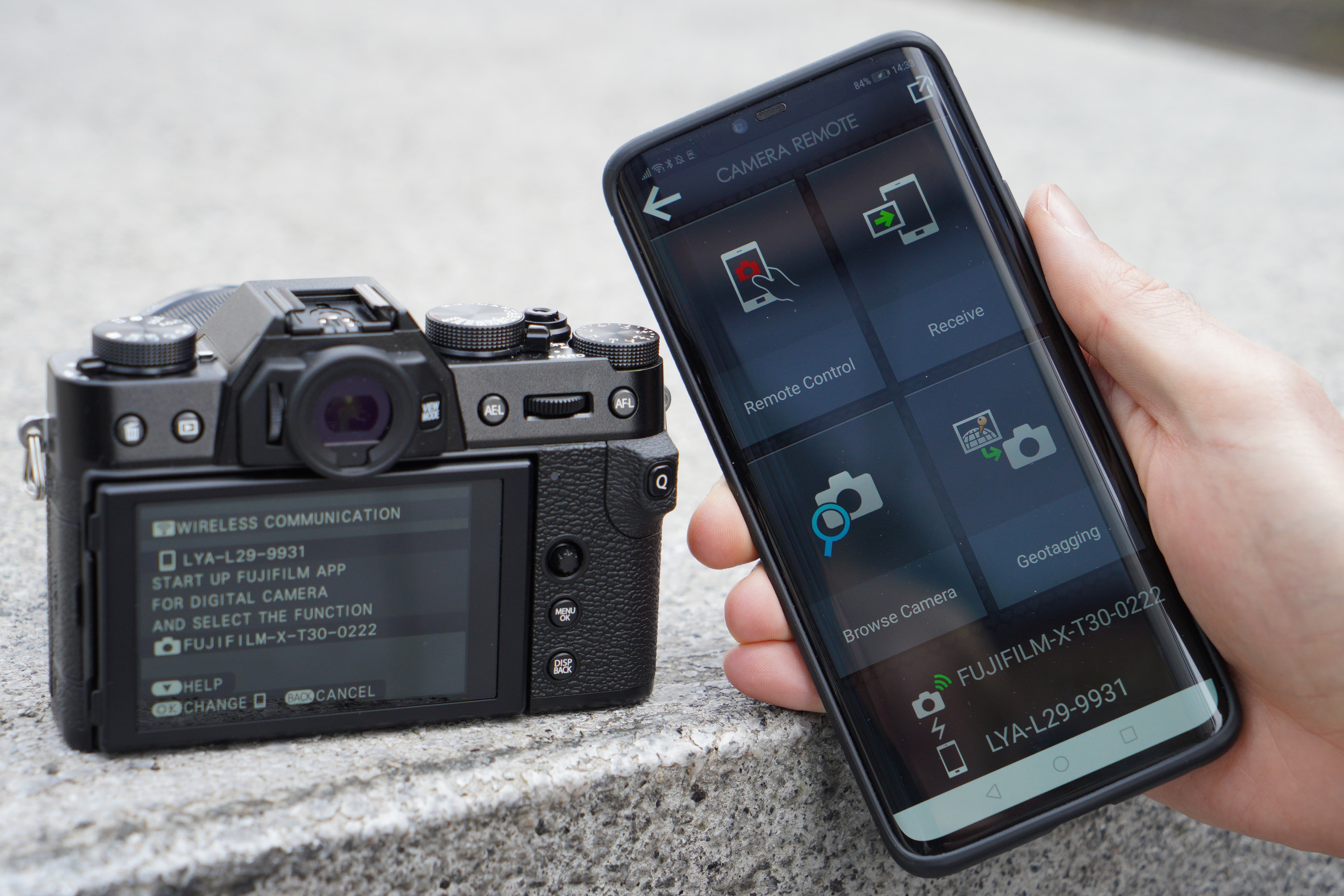
The X-T30 connected to Fujifilm’s easy-to-navigate Camera Remote app
As well as being able to customise the X-T30’s function buttons to wireless communication, this can be assigned to a swipe gesture on the rear screen. Users can also turn Auto Image Transfer on, which sends the last batch of captured images to the mobile device the next time a connection is established. A 3MP resize option is set as default and helps to keep file transfers quick and not fill up too much precious memory space.
Fujifilm X-T3 Review: Build & Handling
Fujifilm had good foundations on which to build the X-T30. Though it differs from the X-T10 and X-T20 in areas of its control layout and thumb rest, the general size and shape of the body hasn’t changed. The body is constructed to a high standard. It has more of a robust feel than the X-T100, but isn’t as hardy as the X-T3.
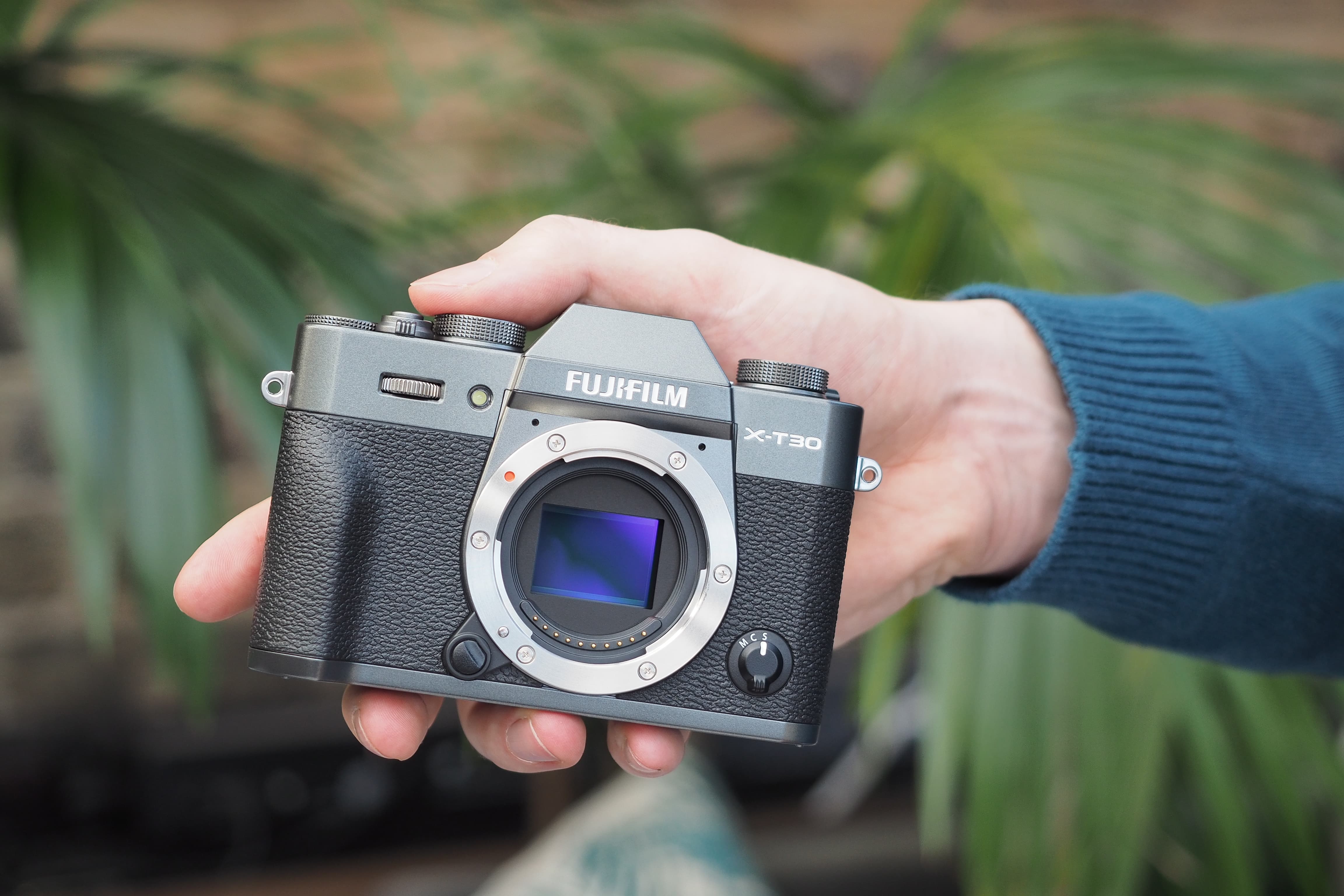
The X-T30 has a sculpted handgrip, however it’s noticeably smaller than the X-T3’s
The top and base plates are made of lightweight magnesium alloy, which contribute to a solid feel. It isn’t weather sealed and doesn’t provide the same level of robustness or durability as the X-T3, but should last a long time in the hands of those who care for it. If you like to venture off limits and want reassurance that your camera is up to the task of shooting in seriously challenging environments, the X-T3 with its seals against moisture is probably the better option for you.
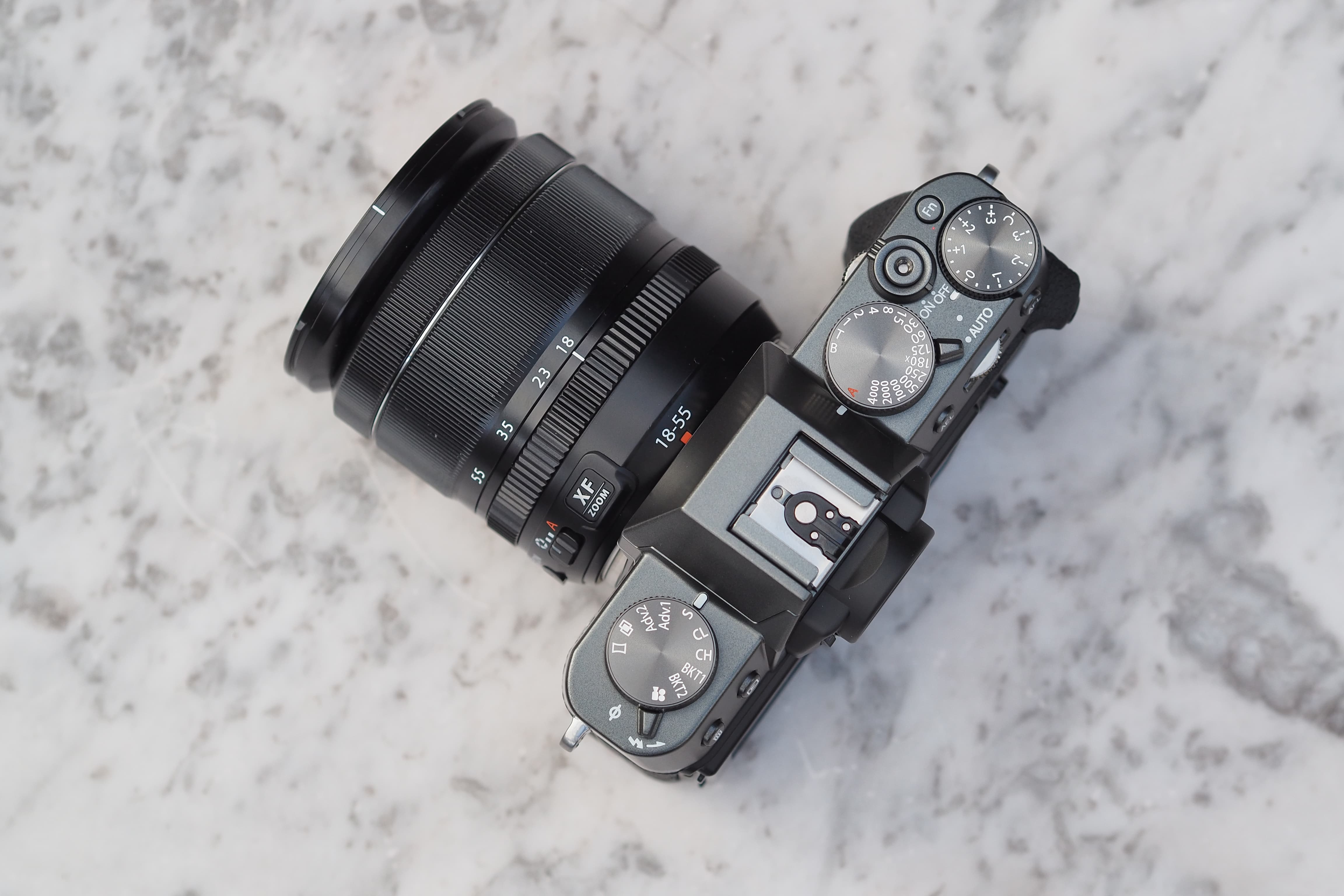
There’s a switch just off from the drive mode dial that’s flicked back to raise the built-in flash
Compared to the X-T3 the X-T30 is rather dinky, but the handgrip, prominent thumb rest and grippy rubberized coating make for a satisfying feel in the hand for such a small camera. If you have large hands or feel the handling would benefit from a little extra depth to the body, such as when it’s used with heavier lenses, the metal grip Fujifilm makes for the X-T10 and X-T20 also fits the X-T30. This accessory will set you back an extra £99, but it’s better than some cheap third-party alternatives and has a cut out to allow batteries and memory cards to be swapped over quickly and easily.

The function button on the top plate can be activated accidentally when using the camera single handedly
The X-T30 shares a likeness to the X-T3’s top plate, but doesn’t have an ISO dial. Instead, a drive mode dial occupies the real estate on the top plate to the left of the viewfinder, with the two dials on the opposite side controlling shutter speed and exposure compensation. Those who want fast access to ISO can reposition it in the quick menu, or better still, assign it to a function button or the front or rear dial.

The X-T30 features the same electronic viewfinder that you’ll find on it predecessor, the X-T20
The on/off switch that surrounds the shutter button is threaded to accept screw-in style cable releases and there’s a small function button just to the right of it. This is set to turn high performance boost mode on or off as default and there were a few instances when I found myself hitting it unintentionally. To avoid accidental presses this button would benefit from being held for a second before its assigned function becomes active.
So what about the new changes? In the same way the four-way directional buttons were stripped from the X-E3, Fujifilm has taken a similar approach at the rear of the X-T30. It’s the first double-digit X-T camera to feature a joystick. In the past this has been a feature you’d have to pay a premium for on Fujifilm’s more advanced models if you wanted it.

The X-T30’s joystick can be depressed to highlight and change the AF point size. It’s also useful for navigating and confirming changes to settings in the menu
With the joystick falling nicely beneath your thumb, shifting the AF point becomes faster and more intuitive. Depress the joystick and you’re able to quickly refine the size of the AF point with the rear dial too. It also presents an excellent way of navigating the menu and finding the settings you want quickly with minimal thumb movement. This is important because like all other X-series cameras, the touchscreen can’t be used to navigate the menu.
The Disp/Back button remains in much the same place and the Menu/OK button is located directly above it. The introduction of the joystick where the quick menu button used to be has required the latter to be relocated. The quick menu button has been added to the thumb rest, which has a more prominent profile than the X-T10 and X-T20. Like the Fn1 button, I found it easy to brush against it when shooting single handed. Loading the quick menu accidentally became frustrating after a while, but thankfully Fujifilm has since announced a firmware update (Ver.1.01) for the X-T30 to address this issue. With the firmware installed, it requires a definitive press to load the quick menu.

The ‘C’ setting on the exposure compensation dial enables users to adjust exposure beyond +/-3EV and up to +/-5EV. Depress the front dial and you can easily toggle between exposure compensation and ISO control
Like the X-T20, the Auto mode selection lever is in easy reach of the thumb – ideal for less-experienced users who’d like the camera to choose the optimum settings for a given scene. To enter Program mode you’re required to set both the aperture on the lens and shutter speed to its ‘A’ setting. With the shutter speed set to ‘A’ mode and the aperture set via the aperture ring, the camera will actively perform in aperture priority mode; whereas with the aperture set to ‘A’ on the lens and the shutter speed set via the dial, the X-T30 performs in shutter priority mode. This is the same arrangement as the X-T3, but is a slightly different way of working to the PASM shooting modes you’ll find on the entry-level X-T100.
Fujifilm X-T30 Review: Performance
One of the main attractions of Fujifilm’s double-digit X-T series cameras is that they offer a comparable performance to the company’s more advanced single-digit X-T models for less money. Indeed, the X-T30 with its fast performing X-Processor is highly versatile when it comes to shooting different subjects and scenarios, proving itself to be just as capable shooting static subjects and landscape scenes as it is portraiture and high-speed action, sport or wildlife.

Fujifilm X-T30, XF 50mm f/2 R WR, 1/850sec at f/2.8, ISO 200
Just as we witnessed on the X-T3, the wider spread of phase-detection AF pixels combined with quick data processing presents an extremely fast autofocus response. The X-T20 had an evidently snappier AF performance than the X-T10 and the X-T30 improves on the X-T20. One of the claims of the X-T30’s updated AF algorithm is that it focuses faster from far to near or near to far when using phase-detection AF in combination with long telephoto lenses. To test this, I hooked it up to the XF 100-400mm f/4.5-5.6 R LM OIS WR – a fairly large and weighty zoom (1375g) that must be said handles better with the X-T3 than it does the X-T30.
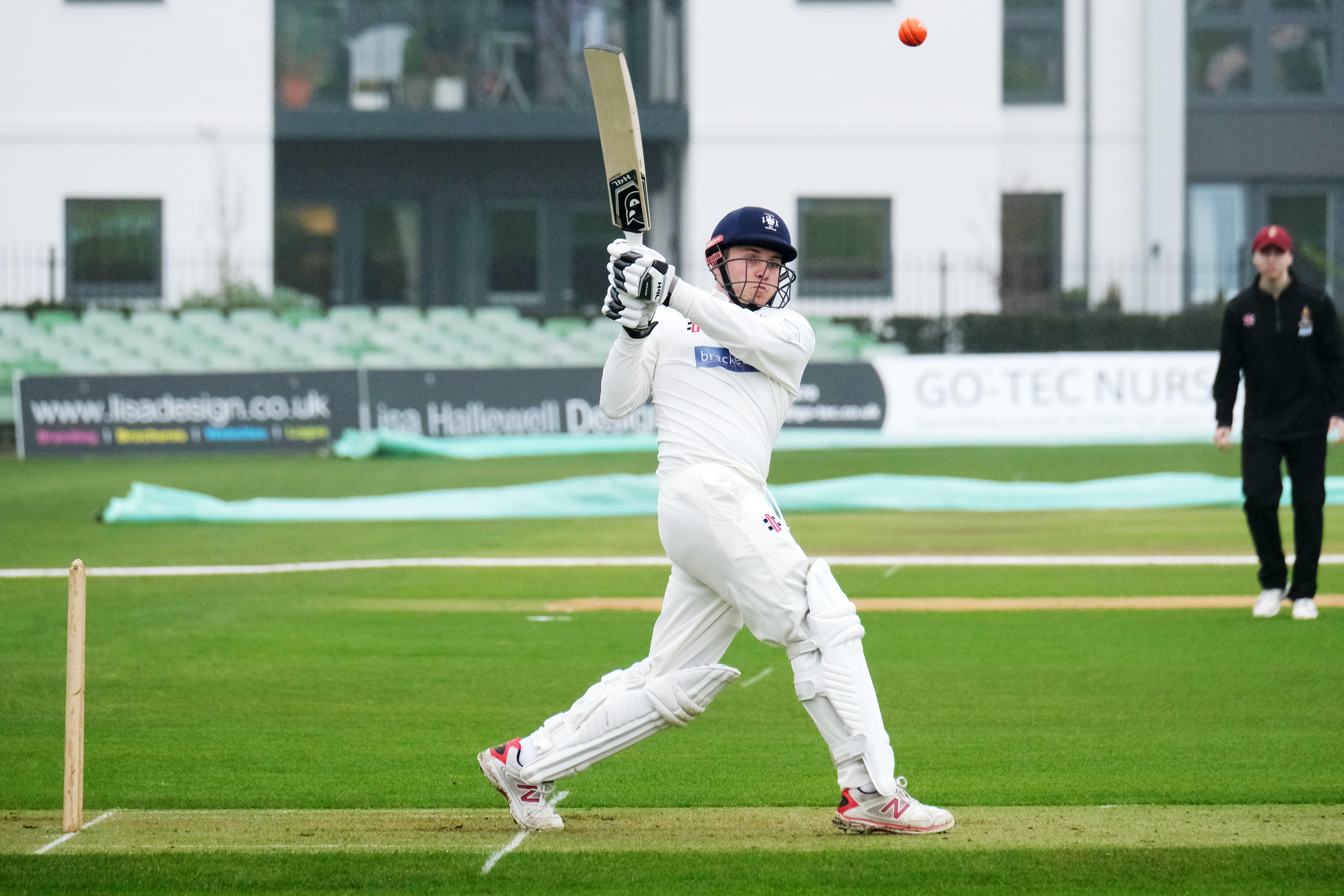
Fujifilm X-T30, XF 100-400mm f/4.5-5.6 R LM OIS WR, 1/2000sec at f/5.6, ISO 1600
Using the lens at its long end and focusing between cricket players at difference distances using single-point AF and Zone AF modes resulted in hasty focus lock with absolutely no hesitation. Shooting high-speed sport at 20fps/30fps using the electronic shutter demonstrated how proficient the X-T30 is at focusing on moving subjects and with no viewfinder blackout beyond the first frame it’s possible to keep apace and track fast and erratic subjects whilst the camera continuously shoots.
Users should be aware of the rolling shutter phenomenon though, which can force you back to shooting at 8fps using the mechanical shutter. Those who photograph moving subjects are recommended to explore the AF-C custom settings as they get more experienced with the camera. These let you fine tune how the camera reacts to the way a subject moves within the frame, how fast the subject moves and where in the frame it prioritises the focus. It’s great to see such an advanced feature filter down to the X-T30 and for users to have the option to refine their own custom preset.

Fujifilm X-T30, XF 18-55mm f/2.8-4 R LM OIS, 1/950sec at f/4, ISO 640
Face and eye detection continues to be an area where camera manufacturers strive to make improvements. The tracking performance of face and eye detection on the X-T30 is promised to be twice as good as the X-T20 and a difference is immediately obvious. The camera does a fine job of recognising faces right across the frame in AF-S and AF-C mode, or when recording video.
When there are multiple faces you can use Face Select to select the appropriate person in the scene using the touchscreen or joystick. I was very impressed by Eye Detection too, which is available in AF-C mode and makes focus tracking on eyes in situations that involves movement far easier. A yellow square inside the green face-detection box highlights which eye it’s locked onto and you can tell the camera which eye to focus on, whether it be the left, right or eye that’s closest to camera. It’s more effective at identifying smaller faces in the frame than the X-T20 and those who like to shoot shallow-depth of field portraits will find they’re able to rely on it to find the crucial point of focus.

Fujifilm X-T30, XF 50-140mm f/2.8 R LM OIS WR, 1/800sec at f/2.8, ISO 400
Using the X-T30 on a short trip to Rome was a great way of finding out how it fares as a travel camera. Being as small as it is it’s easy to shoot discreetly without drawing too much attention to one’s self, with down sampled 3MP images transferring to my smartphone in a matter of seconds. It is possible to turn the resize image setting off and transfer full-resolution files, but this takes longer and will eat into the storage capacity of your mobile device.
The X-T30 exposes for scenes and renders natural colour so well that you’ll find images require little, if any, processing work before they’re good to print or publish. For extra impact, some users might like to explore the film simulation modes, with the option to add warmth or cool down monochrome shots being another welcomed addition. The tried and tested TTL 256-zone metering system rarely skips a beat and with the exposure compensation dial directly accessible from your thumb, it’s easy enough to tweak exposure on the fly when it’s required.
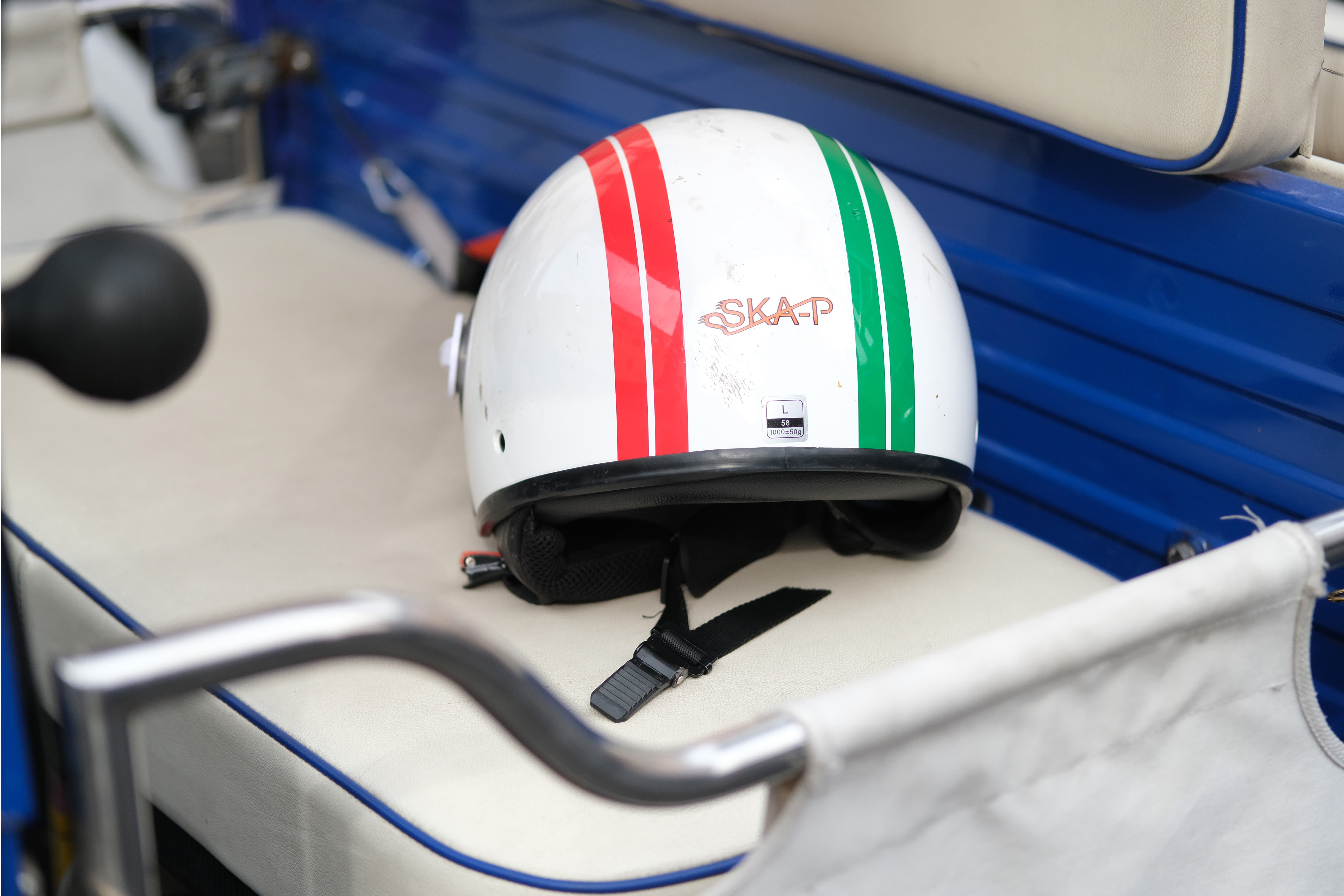
Fujifilm X-T30, XF 50mm f/2 R WR, 1/4000sec at f/2, ISO 640
The status screen, which provides a general overview of all shooting settings, also presents a clear indication of the remaining battery power as a percentage. Users can expect to shoot approximately 380 frames or 45 minutes of 4K/30p footage on a single charge, but if lots of shots are transferred wirelessly you’ll find the battery does deplete faster. Having the option to charge via USB-C as you shoot was a great option to have whilst on my travels. A small icon onscreen tells you when the camera is charging when it’s switched on and a green LED shows when it’s charging when it’s turned off.

Fujifilm X-T30, XF 18-55mm f/2.8-4 R LM OIS, 1/1000sec at f/4, ISO 80
Those who upgrade to the X-T30 from the X-T10 will also find that older NP-W126 batteries are compatible. Other than a few quirks regarding accidental presses of a few buttons and the seemingly backward way ISO is increased/decreased via the quick menu using the rear dial or touchscreen, there’s little to fault on the X-T30. Most importantly, it’s a reliable performer that delivers results that are on par with the X-T3, even when challenged by some of the hardest to photograph subjects and scenes.
Fujifilm X-T30 Review: Image quality
The way the X-Trans CMOS 4 sensor handles noise across its native range (ISO 160-12,800) whilst preserving such a fine level of detail is extremely impressive. This is great news for those who often find themselves pushing the sensitivity high in low-light scenarios. While ultimately the best image quality is resolved from the X-T30’s raw files, JPEG quality straight out of the camera is sublime. Users who shoot JPEGs at high ISOs may want to reduce the automated noise reduction from the menu to produce results that don’t appear as heavily processed. Like the X-T3, the X-T30 manages to record a maximum of 3,400l/ph at ISO 160.
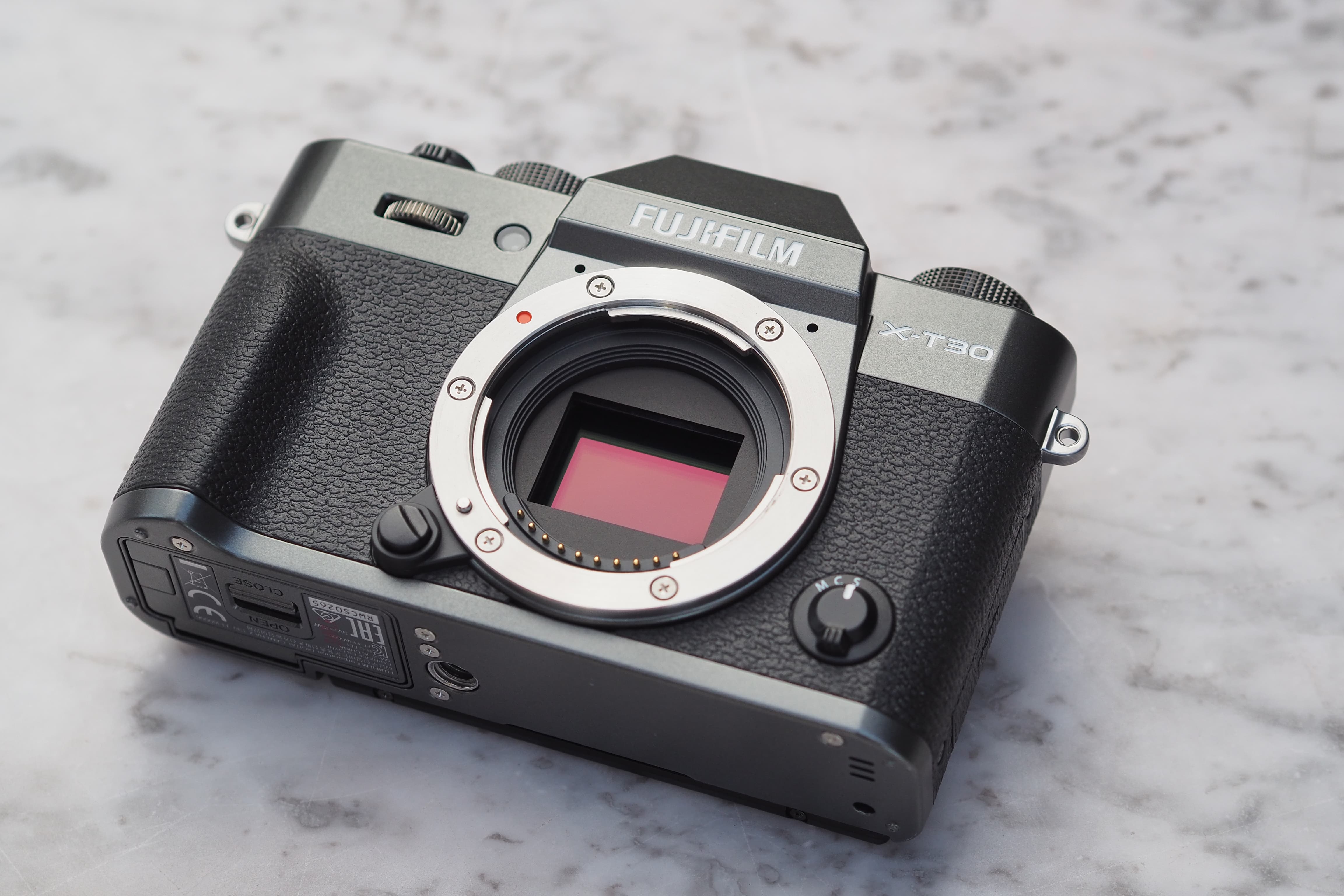
Fujifilm X-T30 Review: Resolution
Below we show details from our resolution chart test pattern. Multiply the number beneath the lines by 200 to give the resolution in lines per picture height (l/ph).
The level of detail recorded by the X-T30’s 26-million-pixel sensor is identical to the detail resolved by the X-T3. The lack of optical low-pass filter plays its part in a maximum of 3,400l/ph being resolved between ISO 80 and ISO 400. Resolution takes a slight hit at ISO 800, dropping to 3,200l/ph. At ISO 3200 and ISO 6400 the figure continues to exceed 3,000l/ph. Heading into the expanded settings revealed a further drop in resolution at ISO 25,600 (2,600l/ph), with 2,400l/ph being resolved at ISO 51,200. Users will find that the expanded settings are easy to locate and are available when shooting in both JPEG and Raw.
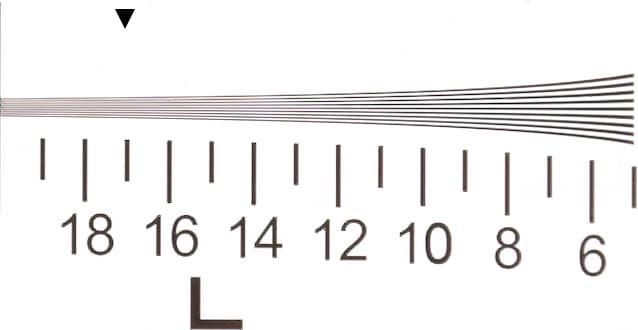
Fujifilm X-T30, Raw, ISO 160

Fujifilm X-T30, Raw, ISO 400
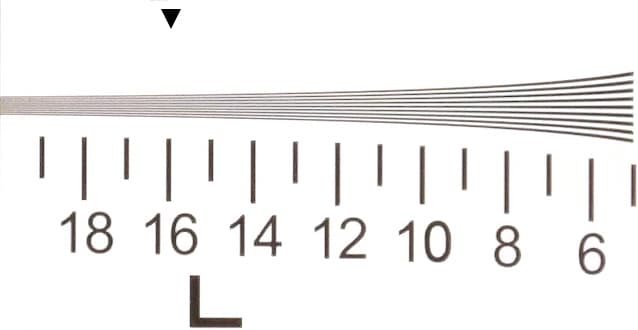
Fujifilm X-T30, Raw, ISO 3200

Fujifilm X-T30, Raw, ISO 6400

Fujifilm X-T30, Raw, ISO 12,800

Fujifilm X-T30, Raw, ISO 25,600
Fujifilm X-T30 Review: ISO and noise
The X-T30’s back-illuminated X-Trans 4 sensor puts in a strong noise performance. Shoot between ISO 80 and ISO 800 and you’ll be guaranteed clean images free of noise. It’s only when ISO 1600 is selected that you start to notice luminance noise appearing, however it’s so well controlled at this point as well as at ISO 3200 that users won’t hold back from using these settings.
Noise is also handled well at ISO 6400, but it does start to become more pronounced in images captured at ISO 12,800. The level of detail that’s resolved at ISO 12,800 isn’t quite what it is at ISO 3200, but this wouldn’t put me off from using this setting when challenged in low light. Users are recommended to steer clear of the extended settings, in particular ISO 51,200.
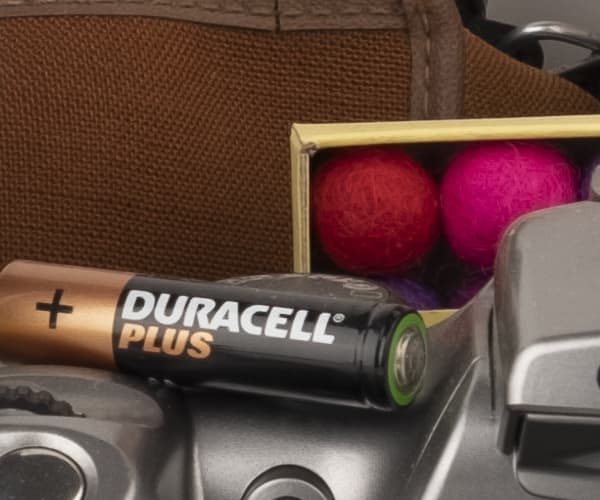
Fujifilm X-T30, Raw, ISO 100
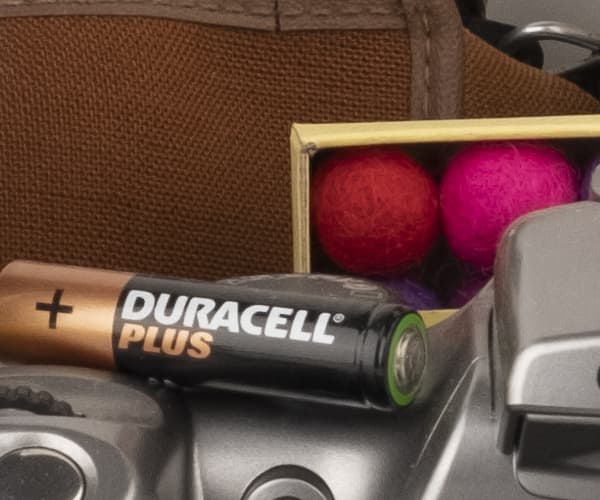
Fujifilm X-T30, Raw, ISO 400
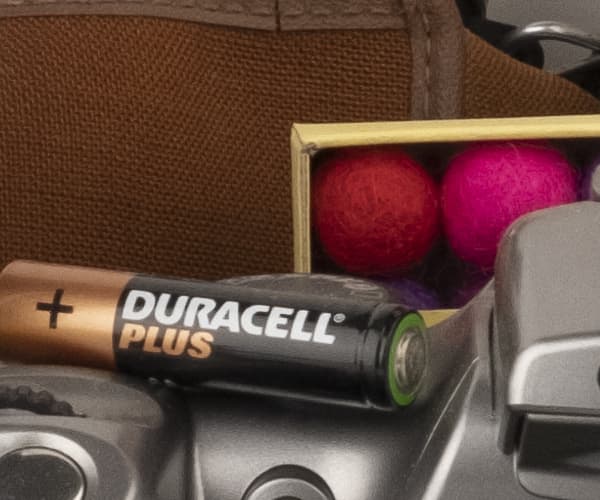
Fujifilm X-T30, Raw, ISO 800
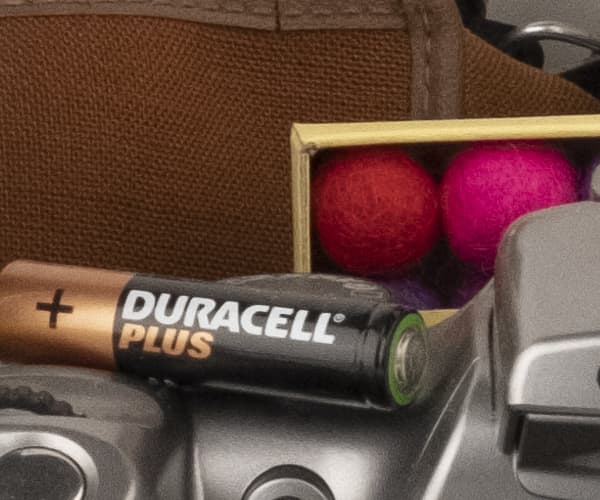
Fujifilm X-T30, Raw, ISO 1600
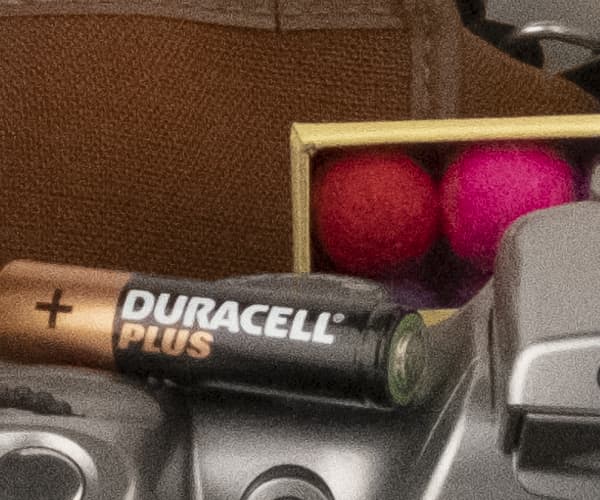
Fujifilm X-T30, Raw, ISO 6400

Fujifilm X-T30, Raw, ISO 12800
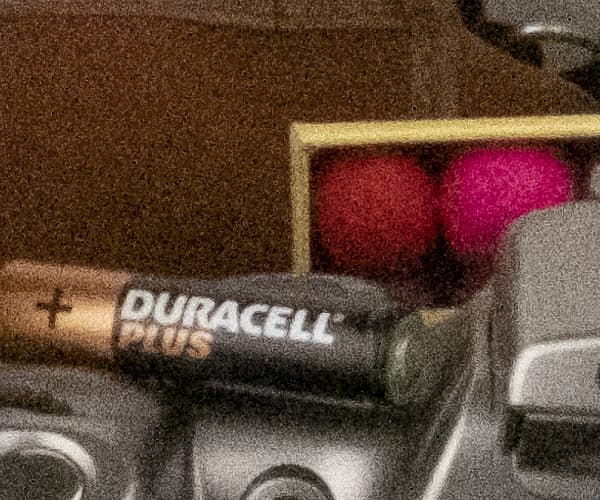
Fujifilm X-T30, Raw, ISO 25600
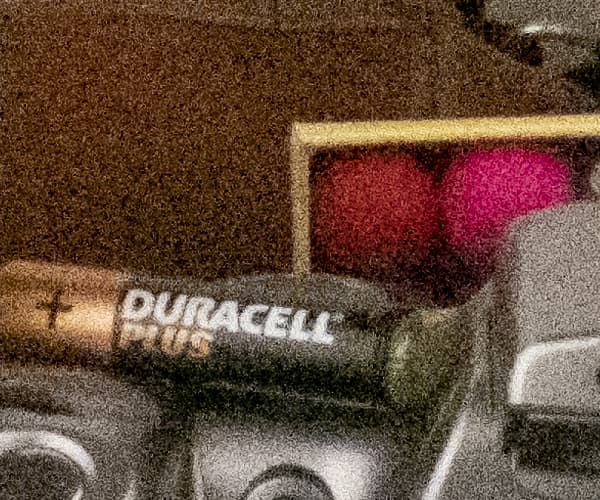
Fujifilm X-T30, Raw, ISO 51200
Fujifilm X-T30 Review: Verdict
The X-T30 positions itself above the entry-level X-T100 and below the senior X-T3 in Fujifilm’s desirable X-T series. In the same way the X-T20 inherited its sensor, processor and other features from the X-T2, the X-T30 does the same from the X-T3, serving it all up in a smaller, lighter body that comes with most of the buttons and dials photographers want to take manual control. The newly added joystick is well positioned for changing the position of the focus point. Controls you won’t find on the X-T30 that you will on the X-T3 are an ISO dial and a dedicated metering mode switch.
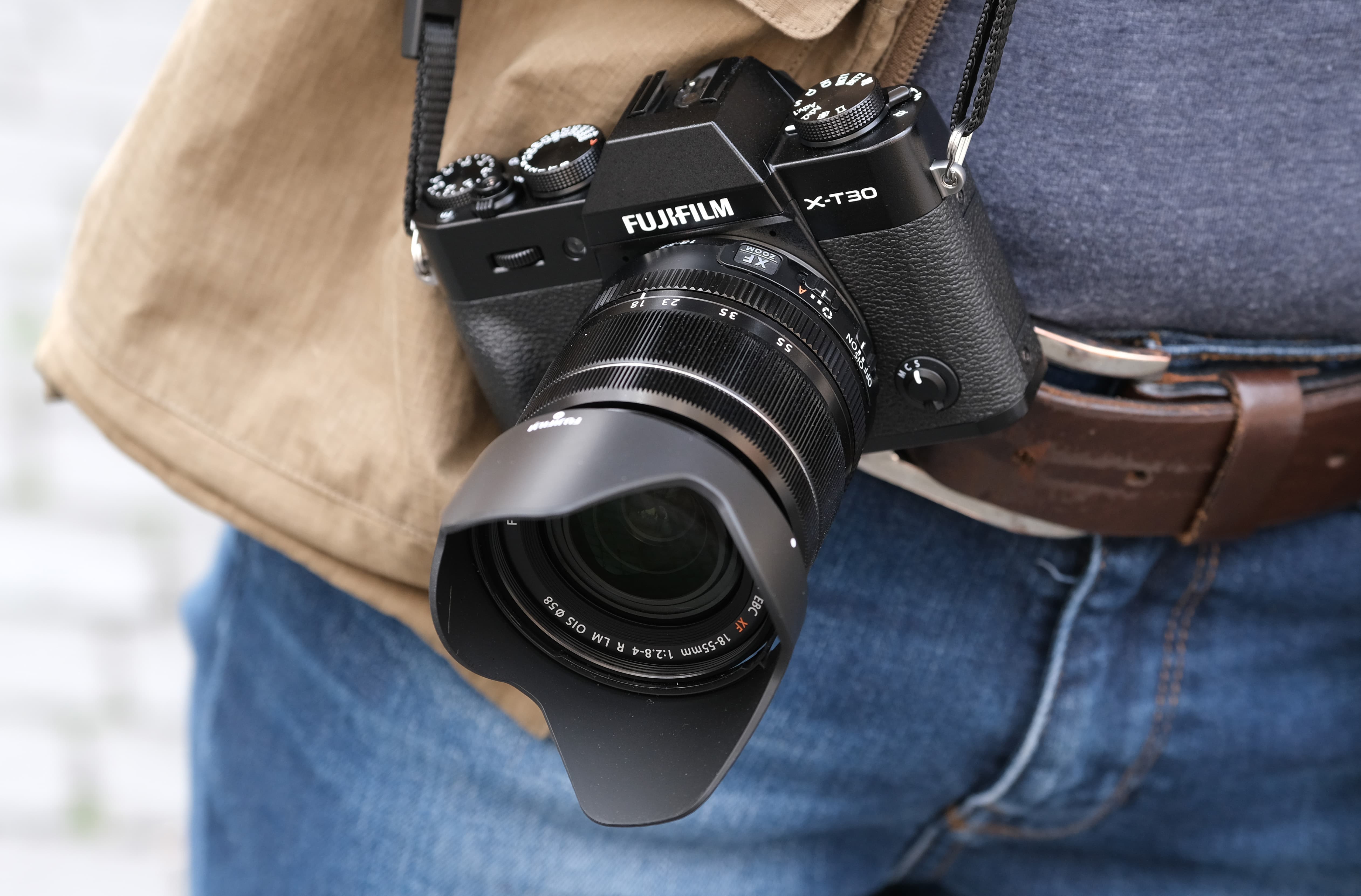
The X-T30 is a great option for times when you’d like to travel light
If you’re sitting on the fence, undecided about whether the X-T3 or X-T30 makes the better buy, you’ll want to question what your main priorities are. If you take your photography very seriously and think you’d reap the reward of owning a camera with a more muscular handgrip, twin card slots for backup purposes, larger and higher resolution EVF, weather seals, bigger buffer, 4K/60p video, the option to shoot up to 11fps with mechanical shutter and attach a battery grip, the extra you’d spend for the X-T3 would be justified.
If however you like the sound of making a £500 saving and feel that some of these premium features aren’t essential to your day-to-day photography, the X-T30 is a cracking buy and will serve amateurs, enthusiasts and even semi pros who want a great little backup body, extremely well. The saving you make over the X-T3 could also be put towards an extra lens or two.

The X-T30 coupled to the new XF 16mm f/2.8 R WR
The petite size of the X-T30 takes up very little space in a camera bag. This makes it a great candidate for travelling, leaving plenty of space for lenses and other essentials. It pairs up and produces great results with Fujifilm’s small and affordable f/2 primes, but the optional metal grip would make a good purchase if you have larger than average sized hands or plan to use it with large lenses frequently.
All things considered, the X-T30 is a marvellous mirrorless camera. It provides an excellent specification and performance for under £1000, whilst preserving the charm and charisma of the X-series that we love so much. Those who choose it will fall in love with it instantly and I foresee the new attractive charcoal grey finish being extremely popular.

Fujifilm X-T30 Review: Hands On First Look
Fujifilm X-T30 : At a glance
- £849.99 (body only)
- Fujifilm X-mount
- 26.1-million-pixel APS-C X-Trans CMOS 4 sensor
- ISO 160-12800 (80-51200 extended)
- 425-point AF system with 2.16-million phase detection pixels
- Up to 30fps continuous shooting with electronic shutter
- 4K/30p video recording with 4:2:2 10bit HDMI output
- Single SD card slot
[jwplayer key=”ac2nCVzy”]
Five months after introducing the extremely impressive X-T3 into its lineup of X-series mirrorless cameras, Fujifilm has followed up with the announcement of its smaller, lighter and more affordable cousin – the Fujifilm X-T30. In the same way the X-T20 was a simplified, more affordable alternative to the company’s X-T2, the Fujifilm X-T30 follows the same ethos and inherits much of what we loved about the X-T3 whilst introducing some autofocus improvements that’ll soon be made available to X-T3 users via a new firmware update.

The X-T30 looks almost identical to the X-T20 when viewed from the front
Fujifilm’s double-digit X-T series models have proven to be hugely successful in recent years. With the X-T20 being touted as the company’s best selling camera ever made, the X-T30 has it all to do if it’s to be as popular as its predecessor. We’ve been told the X-T20 will continue to be sold alongside the X-T30 and won’t be discontinued straight away.
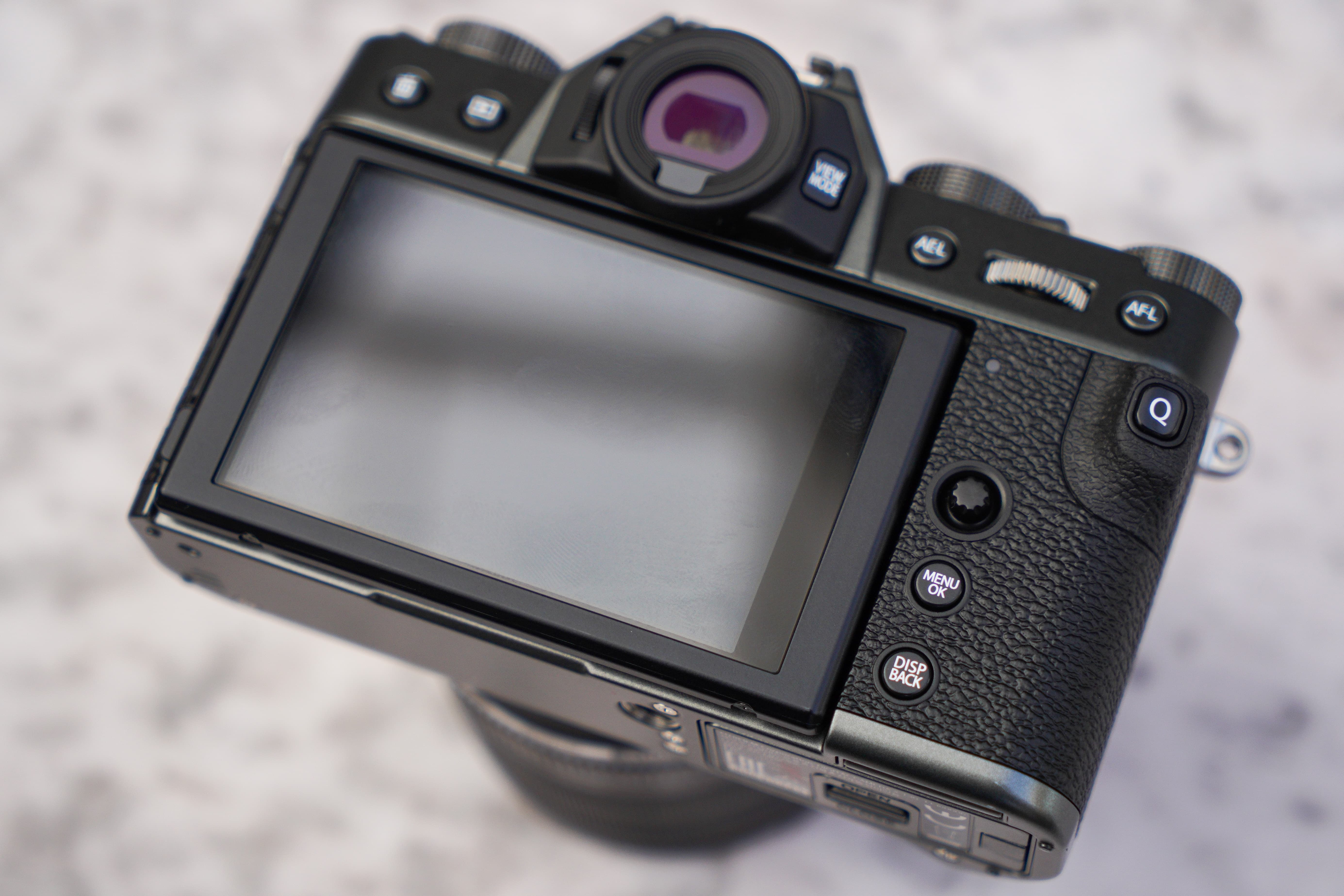
The X-T30 introduces design changes at the rear. Note the new joystick and thumb rest
The Fujifilm X-T30 appears little different to the X-T20 when it’s viewed from the front. It shares the same boxy, high-shouldered design as its forerunner and is noticeably smaller and more compact than the X-T3 when the two are viewed side by side. Under its skin and at the rear of the camera it’s a different story. There are a number of areas where the X-T30 differs from the X-T20 to make it stand out in the market and gain interest from amateur and enthusiast photographers looking for a capable and attractive looking camera that costs less than £1,000 with a kit lens.
Features
The X-T30, like the X-T3, benefits from Fujifilm’s 4th generation X-Trans CMOS 4 technology and is equipped with the company’s latest 26.1-million-pixel APS-C X-Trans CMOS 4 sensor. This fourth generation sensor has a back-illuminated structure, excludes a low-pass filter to enhance image quality and partners up with Fujifilm’s X-Processor that’s 3x faster than the one used inside the X-T20. This combination has seen the sensitivity range increase, albeit very slightly. Previously ISO 160 was only available as extended ISO, but now it’s part of the native range, which spans from ISO 160-12,800 (expandable to ISO 80-51,200).
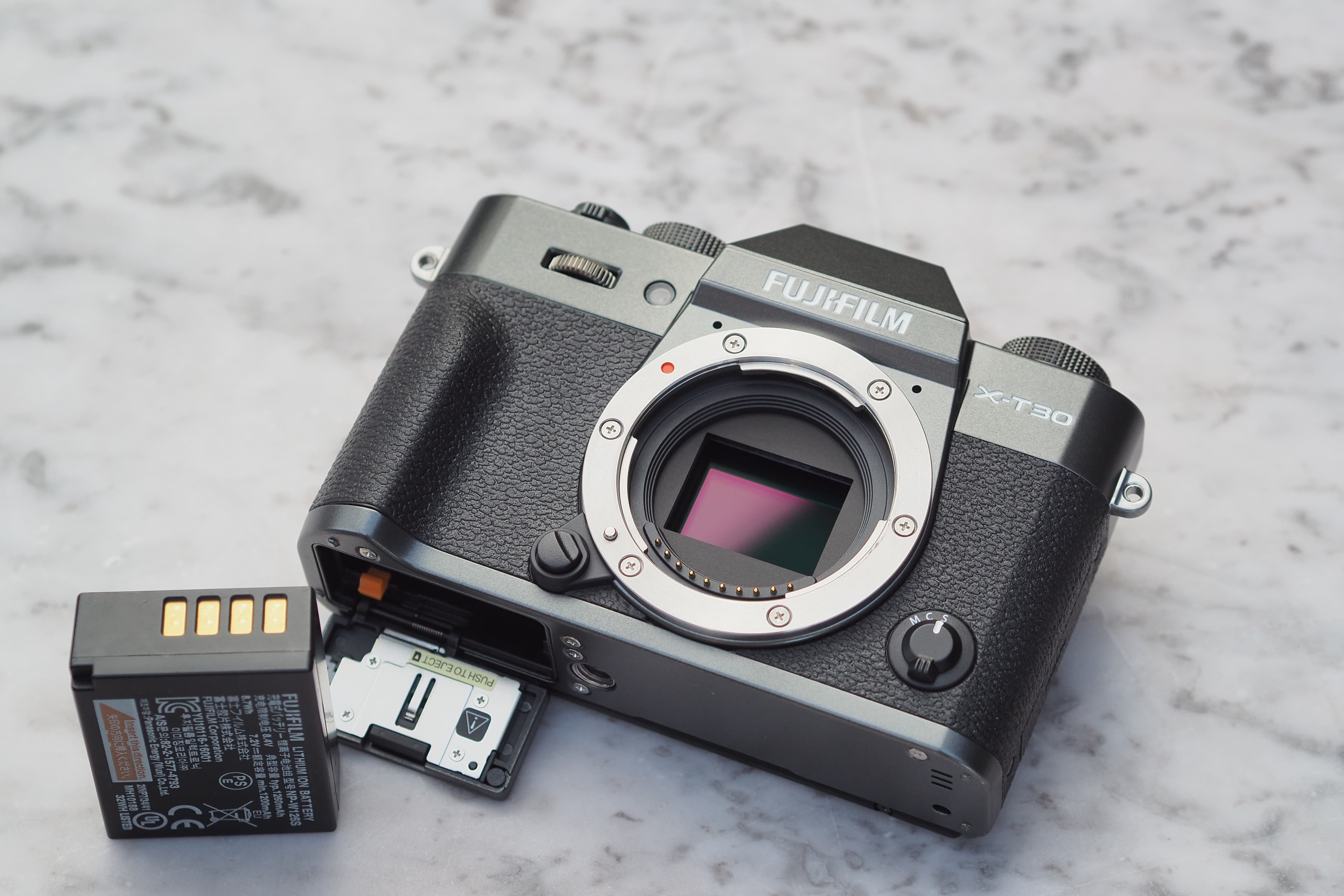
The X-T30 accepts a NP-W126S lithium-ion rechargeable battery and has a single SD card slot
Compared to the X-T3, which can shoot up to 11fps using its mechanical shutter, the X-T30 shoots at a maximum speed of 8fps using its mechanical shutter. Faster continuous shooting speeds of up to 30fps can be reached by employing the electronic shutter, however it should be noted that this enforces a 1.25x crop of the sensor, resulting in a 16-million-pixel resolution image. The fastest the X-T30 can shoot using its electronic shutter without the 1.25x crop is 20fps. The buffer isn’t as large as the X-T3’s, however it can still sustain 32 JPEGs or 17 Raw files at 20fps and 90 JPEGs or 18 Raw files at 8fps.
Another difference between the X-T30 and X-T3 is that the latter can shoot up to 1/8000sec using its mechanical shutter, whereas the maximum shutter speed on the X-T30 with the mechanical shutter deployed is 1/4000sec. For times when a faster shutter speed is required or silent operation is essential, the electronic shutter can be used to shoot at up to 1/32,000sec.

The X-T30 will be made available in black, silver and charcoal finishes
One of the key talking points on the X-T30 are the improvements that have been made to its autofocus system. It inherits the same sophisticated AF system from the X-T3 with four times as many phase detection pixels on the sensor than you get on the X-T20. The 2.16-million phase detection pixels cover 100% of the frame and the low-light autofocus sensitivity has improved from -1EV to -3EV. Users get a choice of either 117 selectable AF points laid out into a 9×13 grid, or there’s a 425-point layout consisting of a 17×25 grid, plus there are custom AF-C modes to enhance focus tracking when shooting moving subjects. These are similar to those on the Fujifilm X-T3, however you don’t get the option to manually adjust the tracking sensitivity, speed tracking sensitivity or zone area switching to create your own custom AF-C preset.
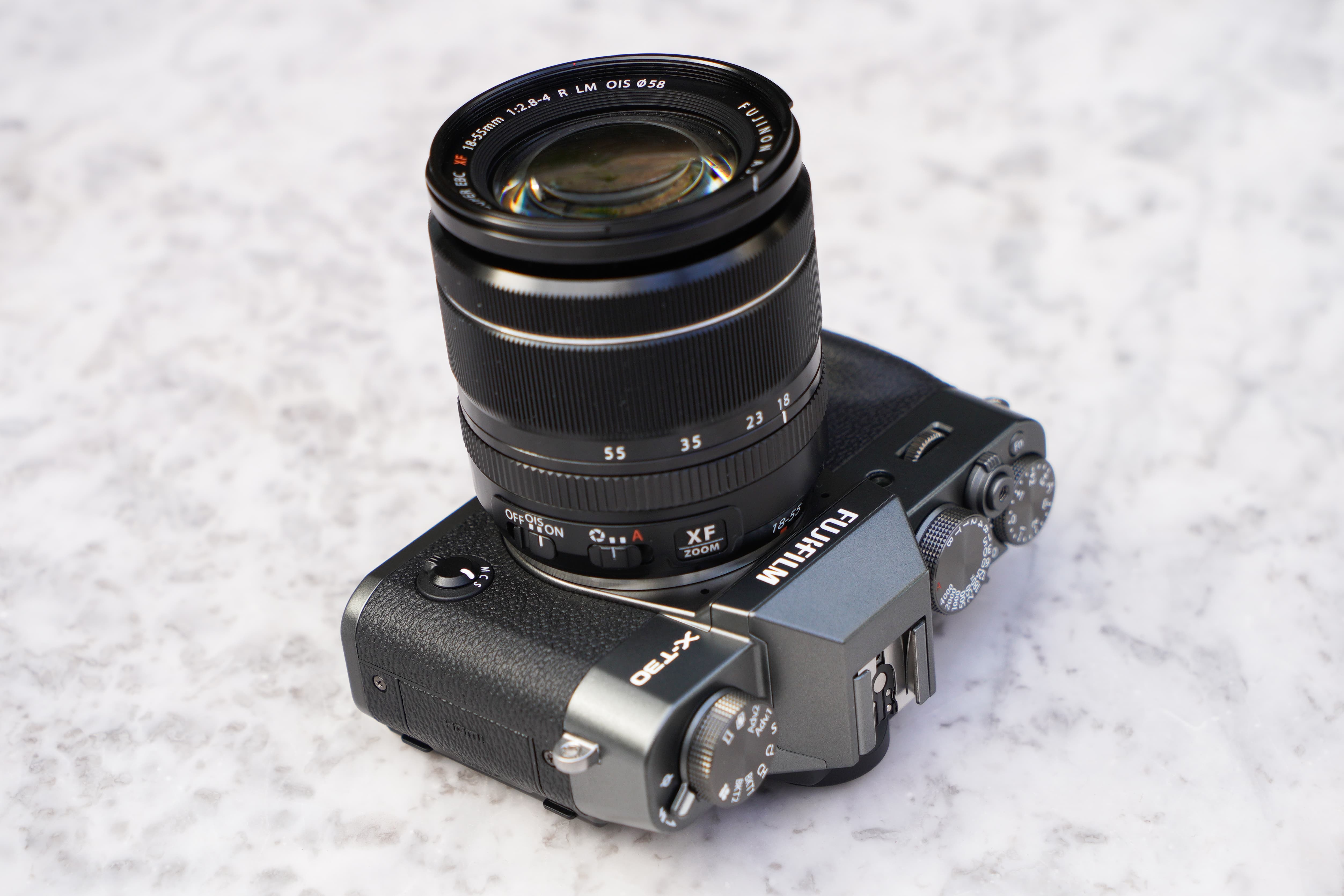
The Fujifilm X-T30 will be sold with the Fujifilm XF 18-55mm f/2.8-4R LM OIS lens for £1,199
Fujifilm has taken the opportunity to update the AF-algorithm on the X-T30, promising improvements to the performance of autofocus in regard to Face and Eye tracking, Face Selection and Non-stop Phase Detection AF when focusing from distance. Following feedback from X-T3 users, the updated Gen. 4.1 AF algorithm is intended to rule out the jittery performance that’s associated with Face and Eye detection and make it smoother. The algorithm has been reworked so it can identify smaller faces in the frame as well as provide faster focusing from far to near or near to far when using phase-detection AF in combination with long telephoto lenses. Fujifilm X-T3 users will be pleased to hear that these improvements will also be made available to them via a firmware update.

A side view showing the X-T30’s USB-C interface inbetween the HDMI and remote ports
Other features that see the X-T30 advance on the X-T20 include its ability to shoot ultra high definition 4K/30p video, supporting 4:2:2 10bit output via HDMI and 4:2:0 8bit output in-camera. It also offers 48KHz 24bit high bit-depth sound recording in body and the USB-C interface that’s found at the side for charging the battery doubles up as as the X-T30’s headphone plug.
All of the above is backed up with all of Fujiflm’s suite of film simulation modes, Bluetooth and Wi-fi connectivity and a renewed version of Fujifilm’s Camera Remote app (Ver.4.0) that’ll be available to download for free on iOS in March and Android in May.
Viewfinder & Screen
At the rear, the X-T30’s 3in, 1.04-million-dot touchscreen features two-way tilt manoeuvrability and has been made 1.3mm thinner than the screen you’ll find on the X-T20. Fujifilm’s engineers have refined the responsiveness of the touchscreen too, which has been improved to make it easier to select settings from the quick menu, move the AF point, fire the shutter or swipe through images in playback mode.

The screen offers two-way tilt manoeuvrability
Just above the screen, the X-T30’s centrally-placed electronic viewfinder is a similar 0.39in, 2.36-million-dot OLED unit as found on the X-T20. It features a 0.62x magnification, dioptre adjustment, and an eye sensor that permits automatic switching with the rear screen. Raise the viewfinder to your eye and you’ll find it displays extensive exposure information, including an electronic level and live histogram. The information also automatically rotates when composing and switching between the landscape and portrait shooting orientations.
Build & Handling
Although the X-T30 is identical in size and build quality to the X-T20, a few changes have been made to the rear to make it better from an operational and handling perspective.
Unlike the X-T20, which requires the AF point to be repositioned using the d-pad, the X-T30 replaces this with a joystick like you get on the X-E3 and X-T3. This allows the AF point to be shifted around the frame using your thumb, which feels natural and intuitive. The new joystick also presents an excellent way of navigating the main menu and finding the settings you want quickly with minimal thumb movement. This is important because like previous X-series cameras, the touchscreen can’t be used to work your way through the main menu.
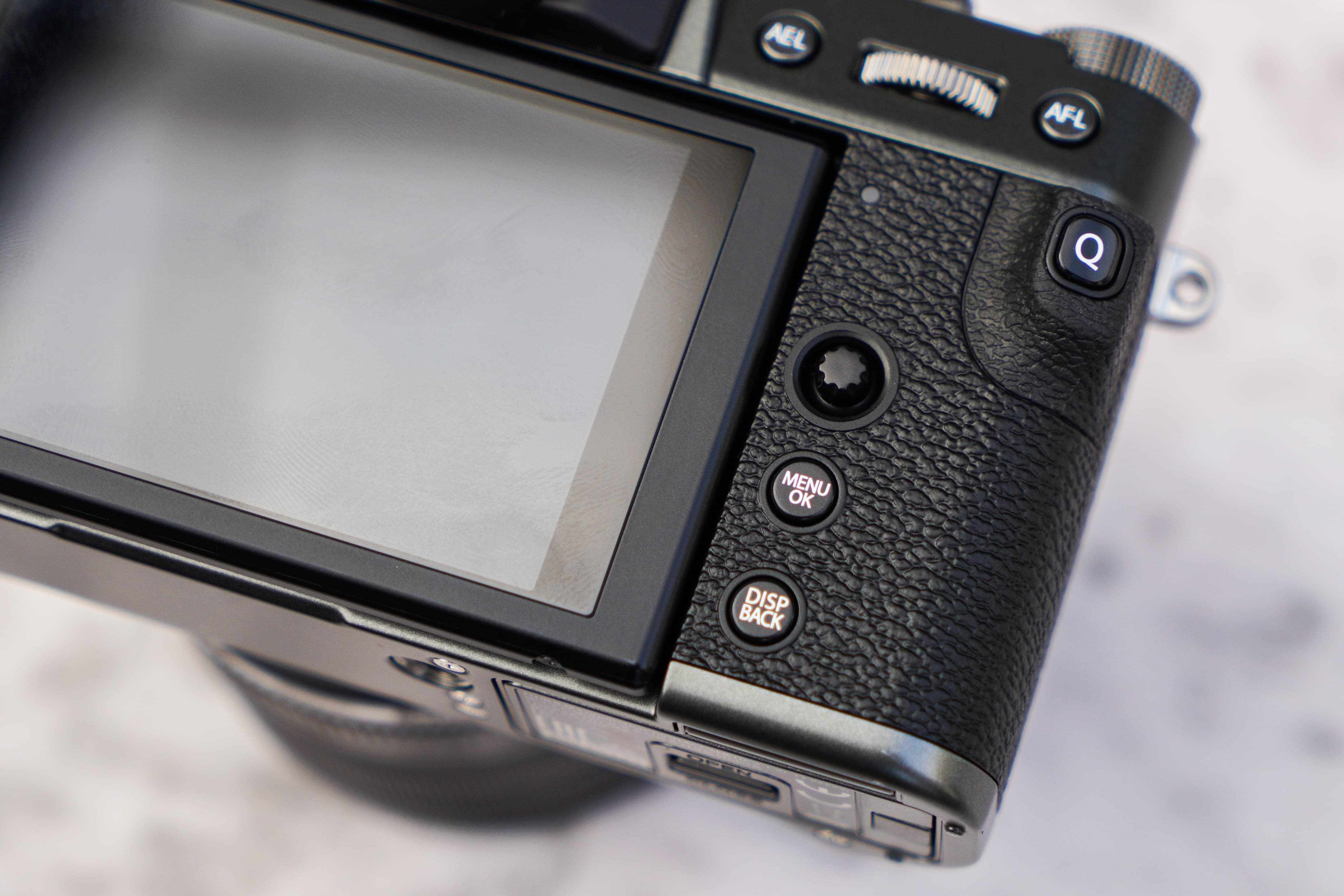
The joystick is well positioned and can be easily located with your thumb
The top and base plates are made of lightweight magnesium alloy, which give it a reassuringly solid feel when it’s picked up. It doesn’t have the same level of robustness and durability that you’d get if you opted for the weather sealed X-T3, but generally speaking it feels well constructed and the body panels don’t creak when it’s squeezed or held tightly. In standard Fujifilm fashion, the body is based around traditional analogue controls, with top-plate shutter speed and exposure compensation dials being complemented by an aperture ring on most Fujinon lenses.

This view of the top plate clearly shows the drive dial, pop up flash switch and hot shoe
The Disp/Back button remains in the same place as before with the Menu/OK button positioned directly above it. The introduction of the joystick where the Q-menu button used to be on the X-T20 forced Fujifilm’s design team into rethinking its positioning. To ensure it remains easily accessible, it has been added to the raised section of the renewed thumb rest.

The exposure compensation dial offers +/-3EV control. There’s +/-5EV control available when it’s set to the ‘C’ setting
In all other respects its much the same as the X-T20. Beginners will appreciate the switch beside the shutter speed dial that gains access to auto mode in an instant, there’s a threaded shutter button to screw in a cable release and full access to the drive settings from the dial on the far left of the body, around which users will find a lever to manually raise the pop up flash when it’s required.
First Impressions
The Fujifilm X-T30 advances upon what was, and still is, a great enthusiast camera. By inheriting the same core features from the X-T3, the X-T30 has been turned into an even faster and more responsive performer than the X-T20 and packs a serious punch for its size.
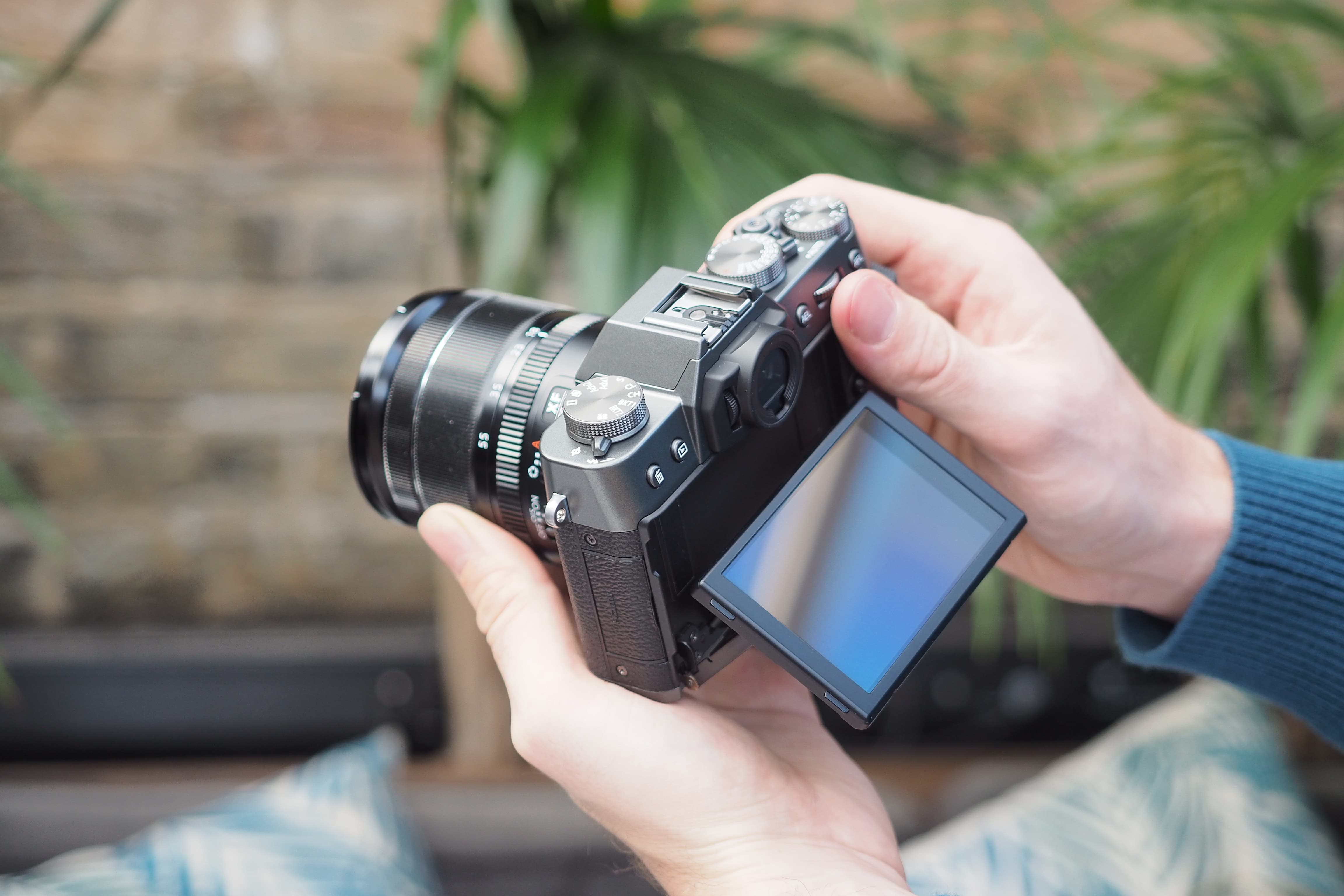
The X-T30’s screen can be easily tilted to aid with high and low angled shooting
During a brief hands-on session we tried out Face Detection and Eye AF, which seemed less jittery and had no issue with recognising small faces in the frame. The touchscreen also responded to soft finger movements on screen and the introduction of the d-pad transforms general operation and positioning of the AF point. Other tweaks to the design such as the improved thumb rest with easy access to the Quick menu are well received too.
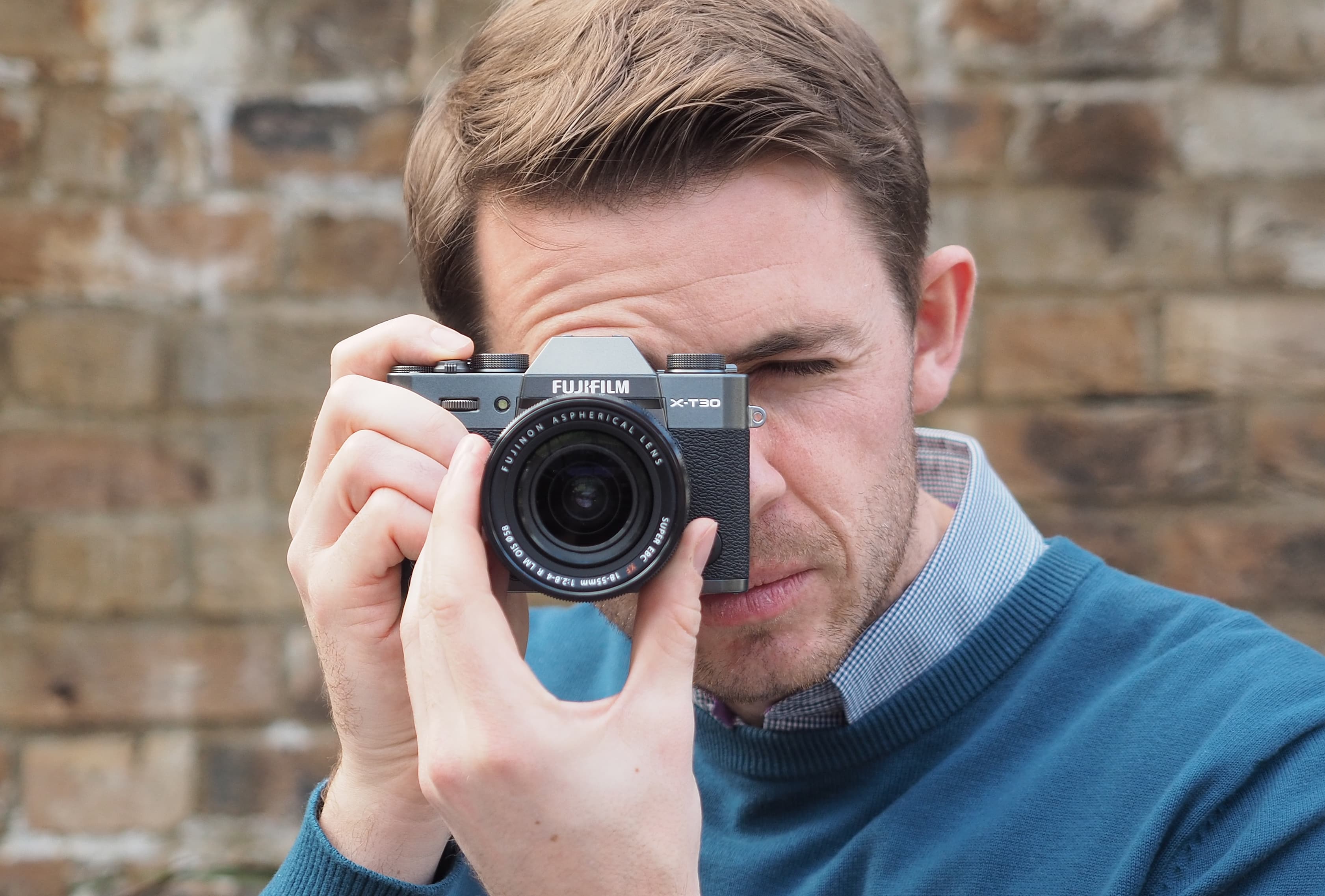
AP’s Michael Topham gets hands on with the Fujifilm X-T30
If your budget can’t stretch to the fabulous X-T3 and you want a lot of what it offers in a smaller, lighter body, the X-T30 ticks a lot of the right boxes. As things stand at the time of launch, the X-T30 costs £500 less than the more advanced X-T3 (£1,349).
If you want dual card slots, a weather-sealed body, 4K/60P 4:2:2 10-bit HDMI output and 4K/60p 4:2:0 10-bit internal video recording, a dedicated ISO dial and the option to add a battery grip to increase shooting stamina, the Fujifilm X-T3 gets the nod over the X-T30.
The X-T30’s form factor and the way it’s supported by the best APS-C-specific lens range currently on the market makes it a very attractive little camera for aspiring photographers as well as capable enthusiasts. Given the choice of the black, silver or charcoal silver finishes, we’d be tempted to choose the charcoal silver option, which is similar to the graphite silver X-T2 Fujifilm made.
Fujifilm certainly look like they’re onto a winner with the X-T30 and we’re looking forward giving it a thorough test when our review sample arrives in a couple of weeks. Watch this space.
Fujifilm XF 16mm f/2.8 R WR
At the same time as announcing the X-T30, Fujifilm has added to their lineup of X-series prime lenses with the release of the XF 16mm f/2.8 R WR (£349.99). First seen on Fujifilm’s stand at Photokina 2018, we now know more information about this smallest and lightest lens in Fujifilm’s compact prime series.
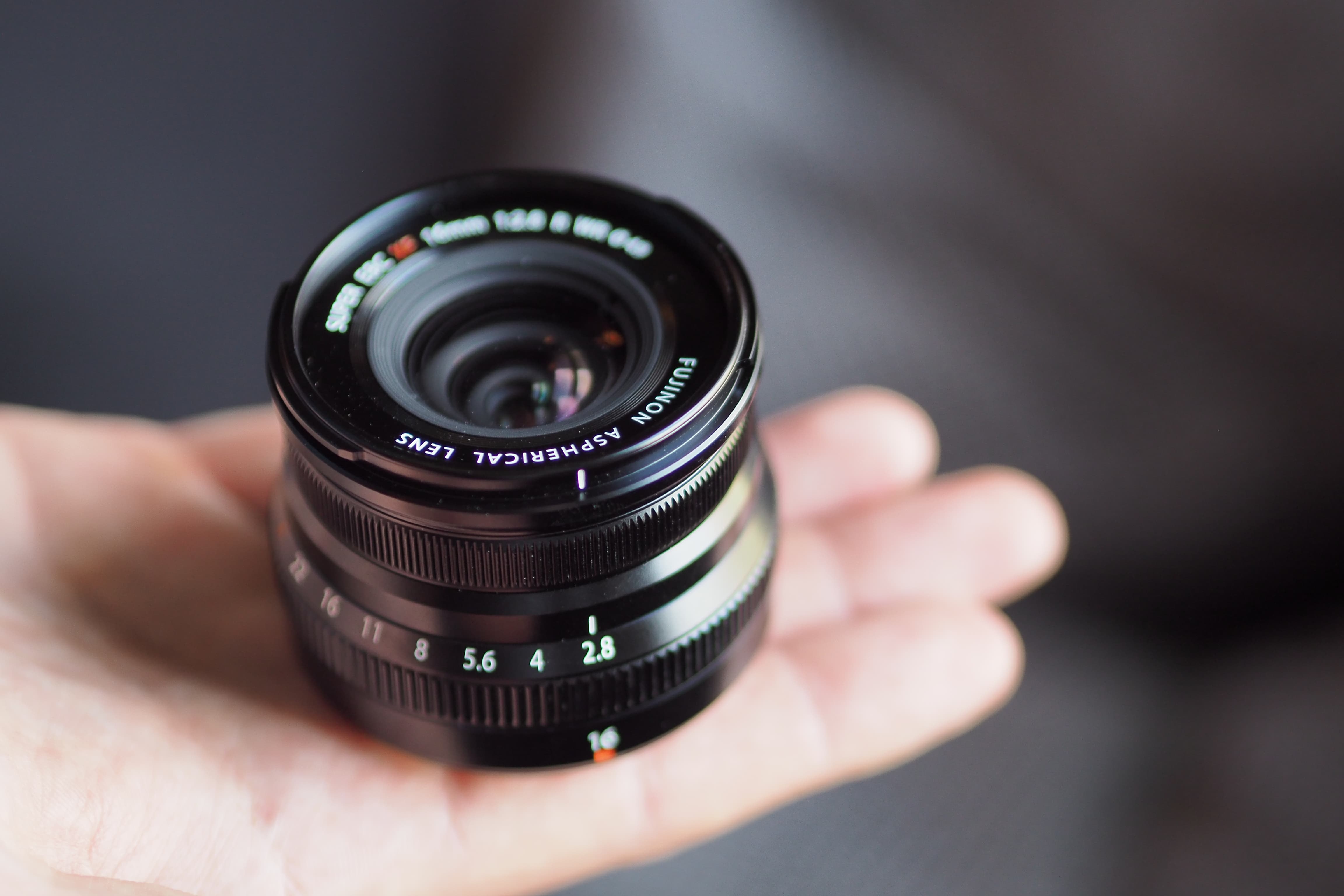
The XF 16mm f/2.8 R WR is the smallest and lightest lens in Fujifilm’s compact prime series
The optical construction features 10 elements in 8 groups including a pair of aspherical elements. The manual aperture ring works across an f/2.8 to f/22 range and it has a minimum focusing distance of 17cm. Its petite size (60×45.4mm) will appeal to X-series photographers who’d like a highly portable and fast wide-angle prime that’s equivalent to 24mm. Just as the WR abbreviation in its name implies, it’s also weather resistant.

The XF 16mm f/2.8 R WR mounted to a black version of the X-T30. A silver version of the lens will also be made available
Combined with the X-T30 it creates an ultra lightweight body and lens combination weighing less than 550g. The lens weighs 155g on the scales, with the X-T30 weighing in at 383g.
Fujifilm X-T3 Firmware Update (Version 3.0.0)
The improvements that have been made to the AF algorithm on the X-T30 will also be available to users of the Fujifilm X-T3 by downloading and installing firmware Ver.3.0.0. As well as improving the speed and smoothness of face detection, obstacles that might come between you and your subject are said to be ignored slightly better. The other improvements the new firmware brings is its ability to detect and track smaller faces in the frame and offer non-stop phase detection AF for a more immediate autofocus response between long distances when using long telephoto lenses.
As well as the improvements to the AF algorithm, the new firmware brings the X-T30’s faster touch screen response to the X-T3. To download the new firmware head to Fujifilm’s support website.
Price and availability
The black and silver versions of the Fujifilm X-T30 will be available to buy from 20th March 2019. The charcoal silver finish of the X-T30 is expected to follow a little later in May. The black version of the XF 16mm f/2.8 R WR is expected in March, with the silver version following in May/June. The full breakdown of pricing is as follows:
- Fujifilm X-T30 (body only) – £849.99
- Fujifilm X-T30 & 15-45mm kit – £899.99
- Fujifilm X-T30 & 18-55mm kit – £1,199.99
- Fujifilm XF 16mm f/2.8 R WR – £349.99







